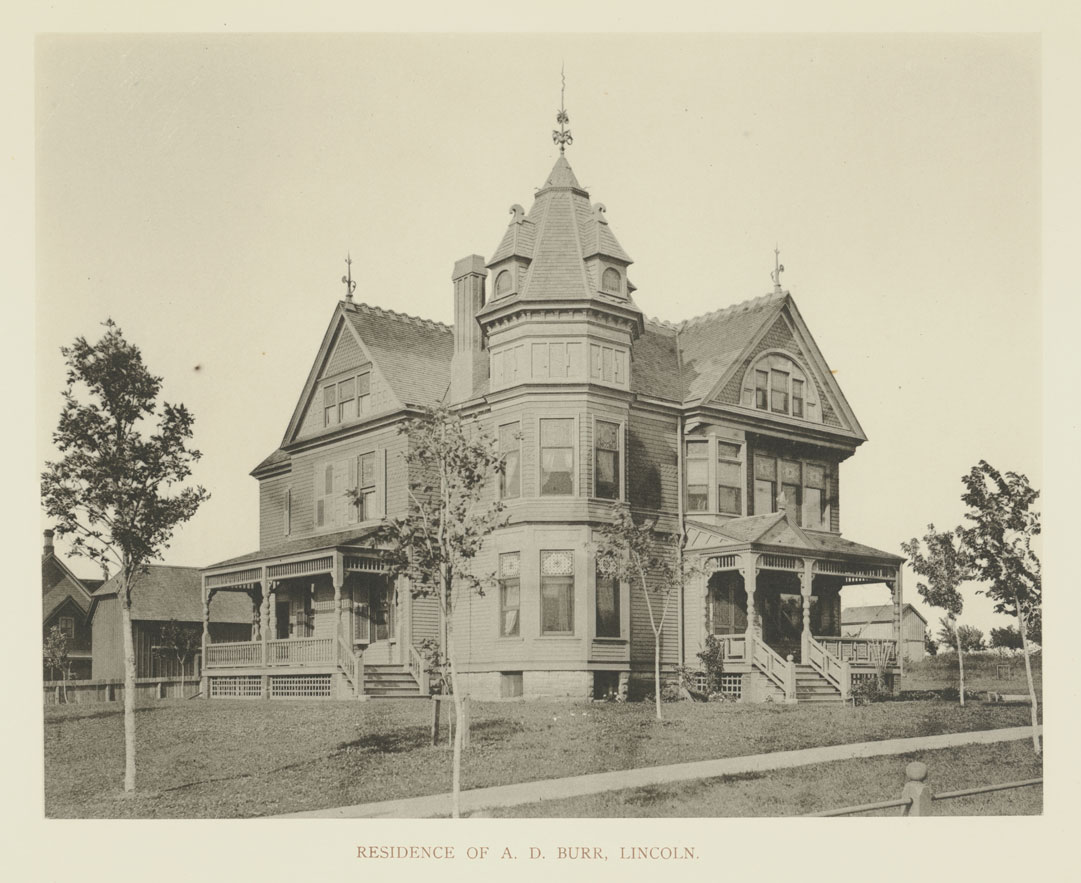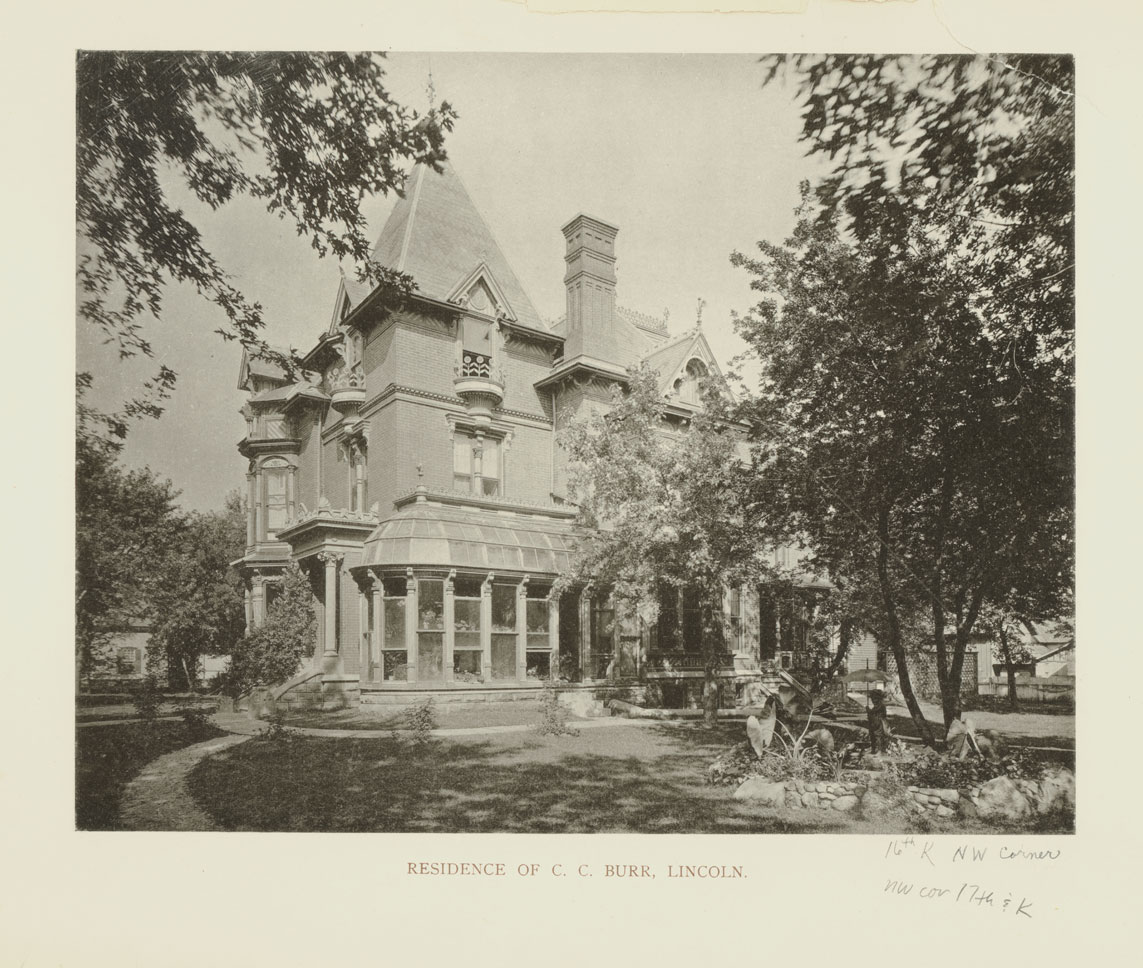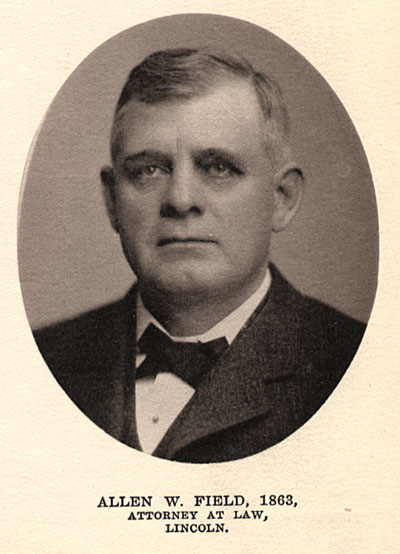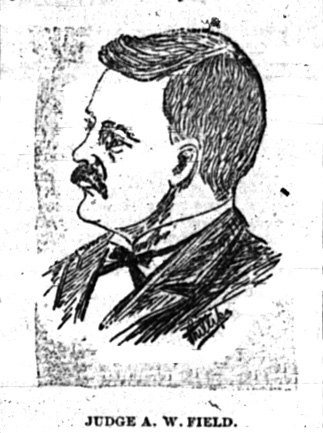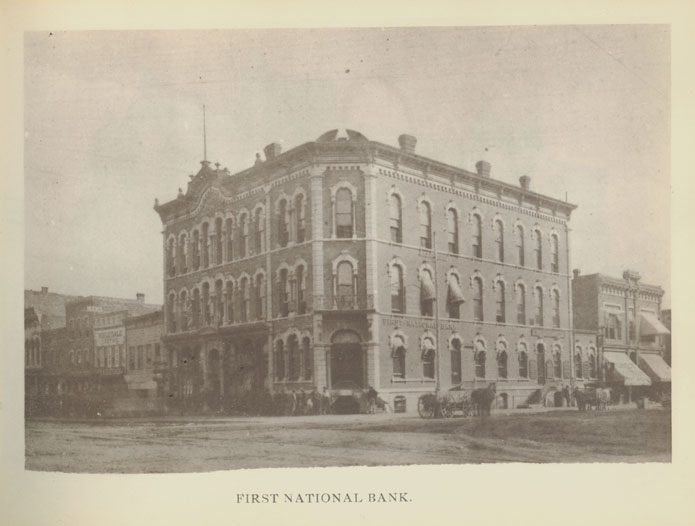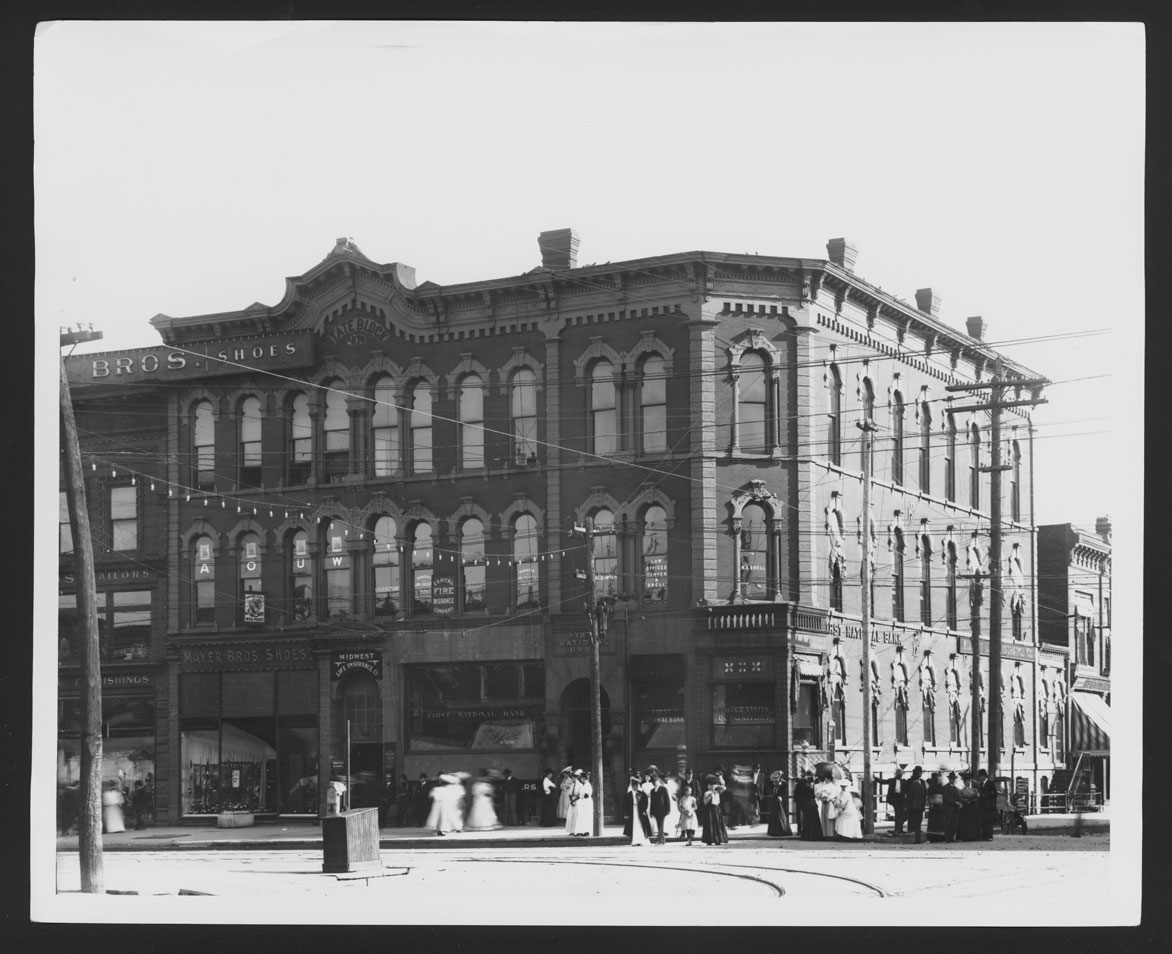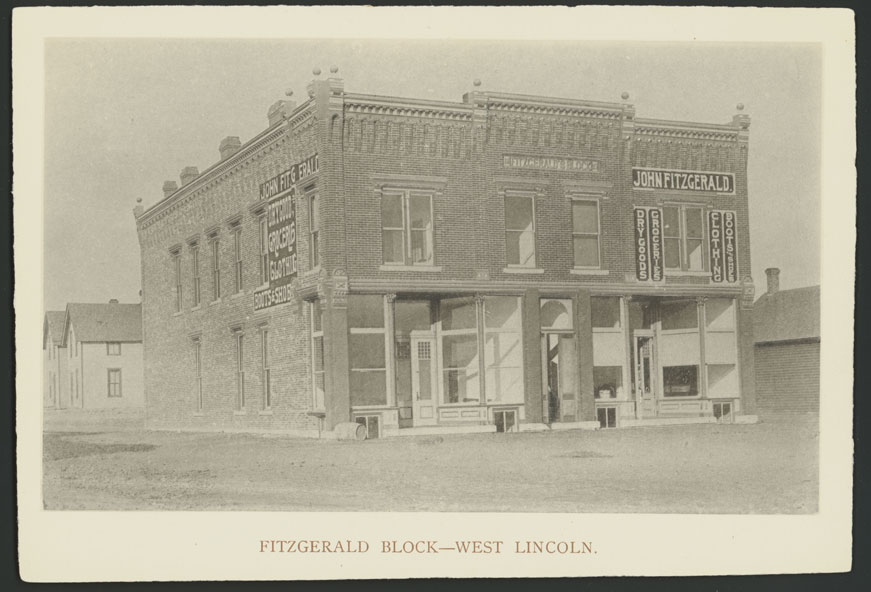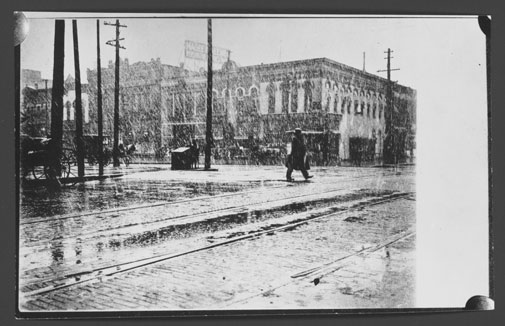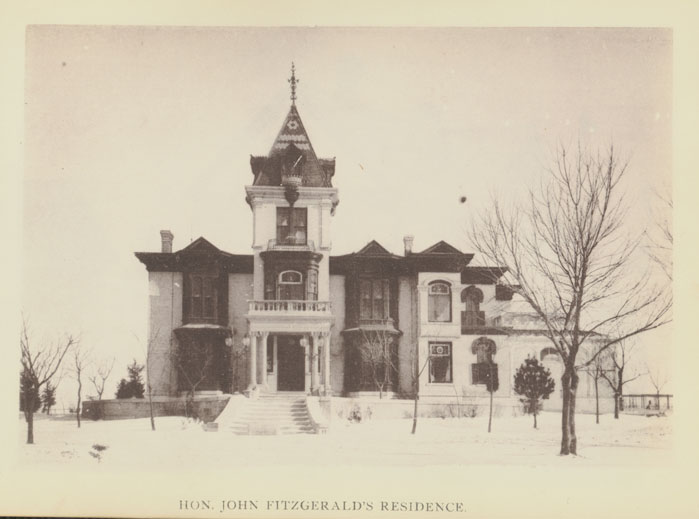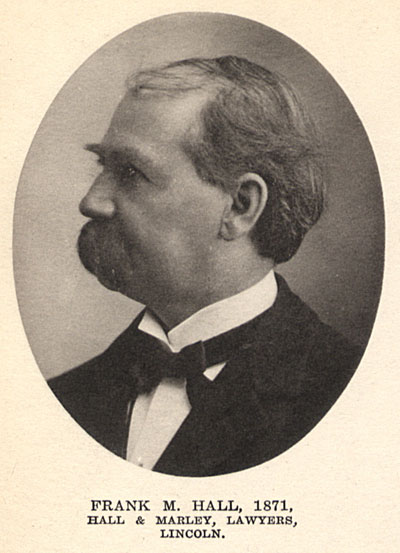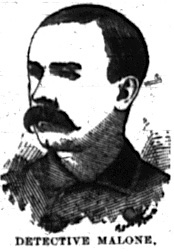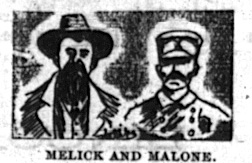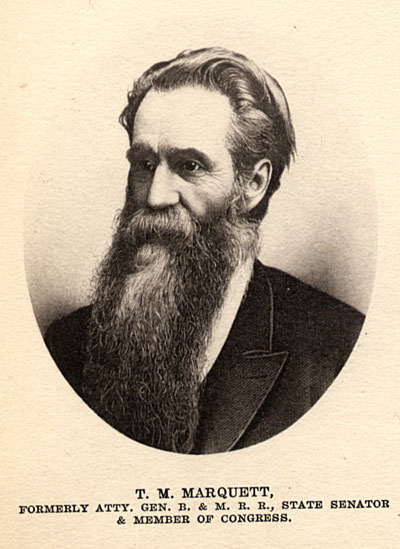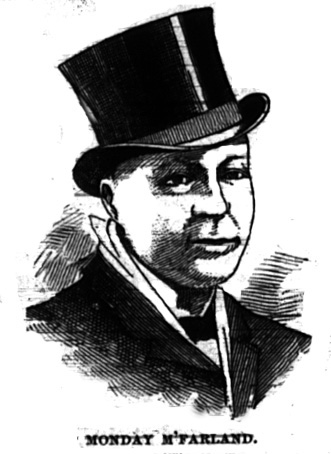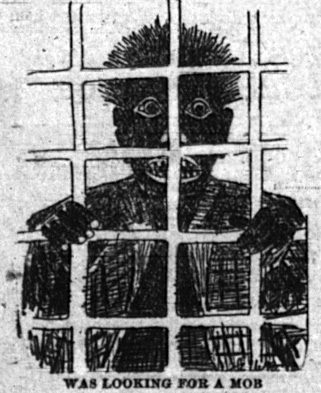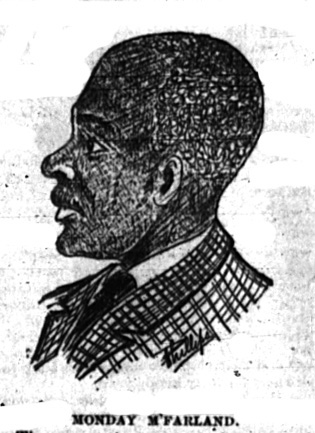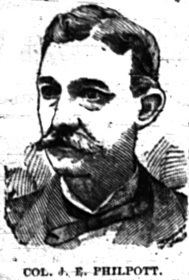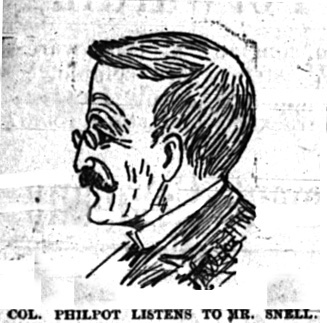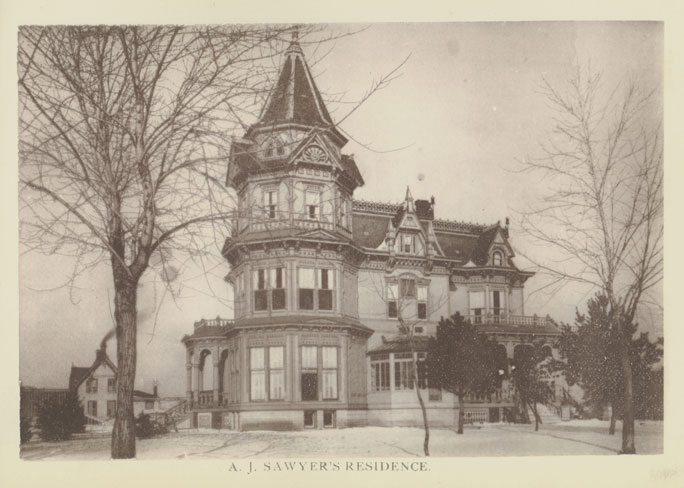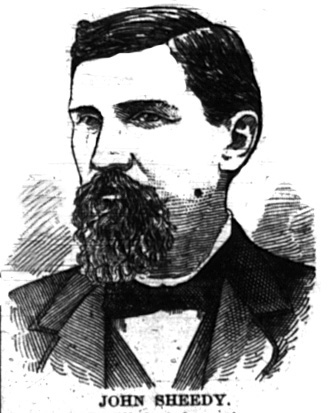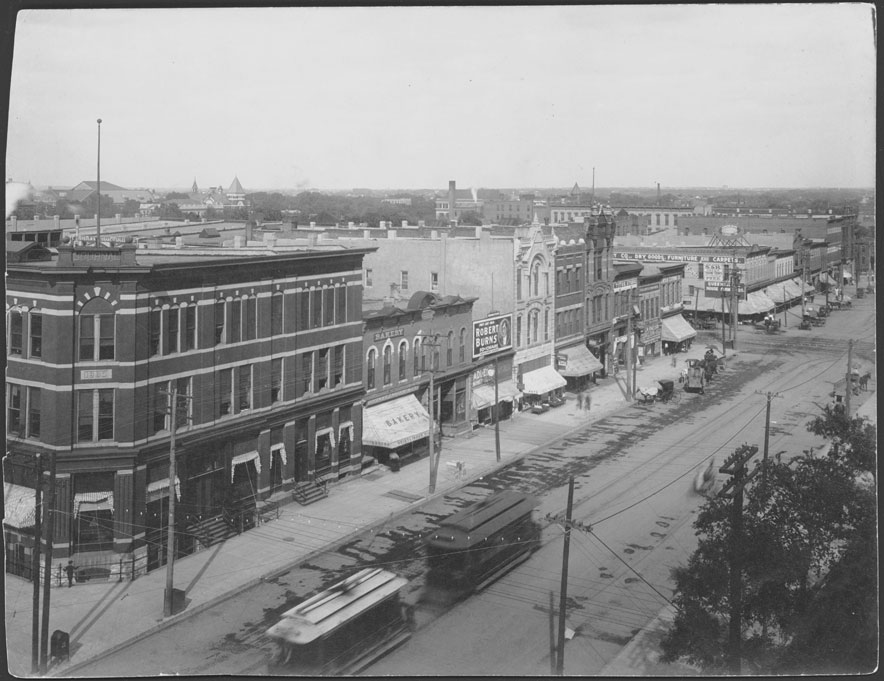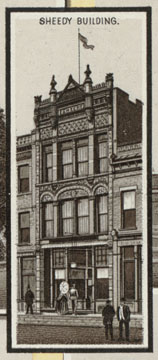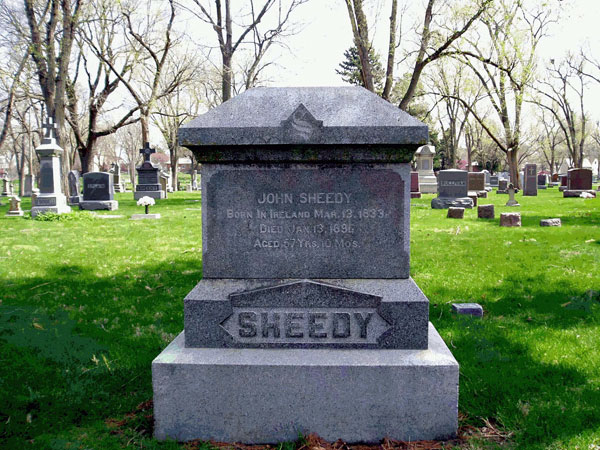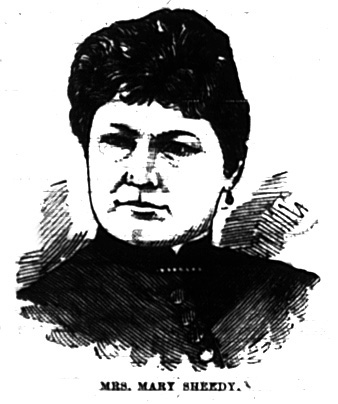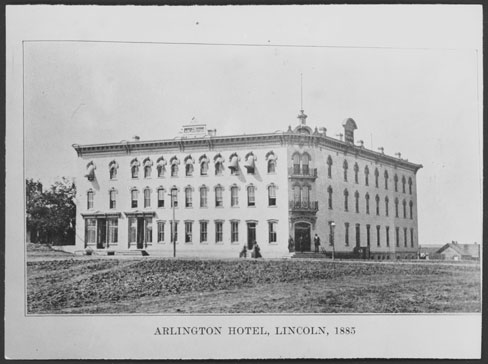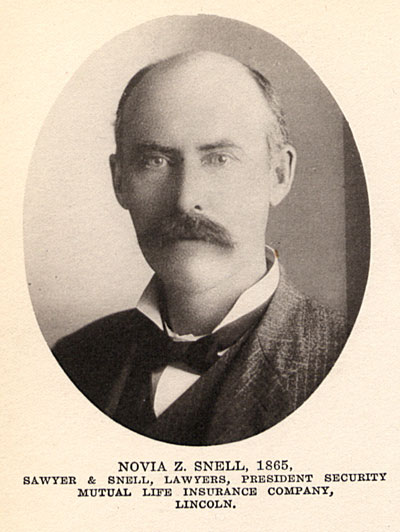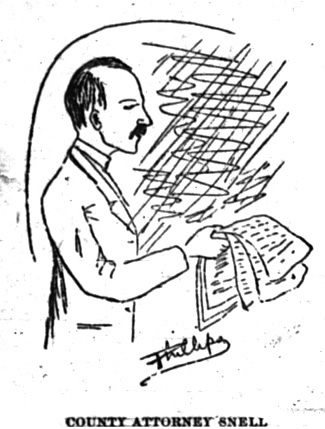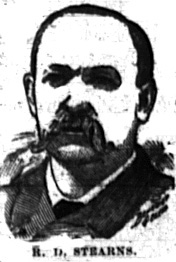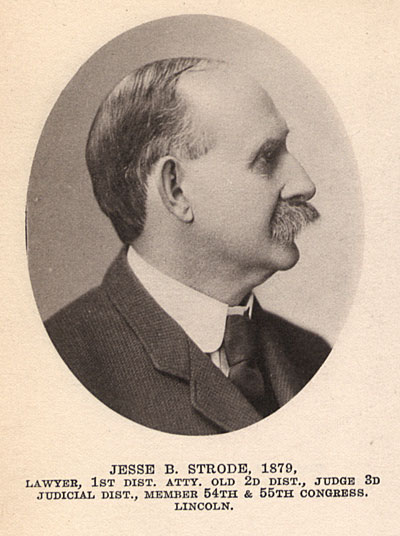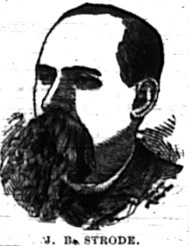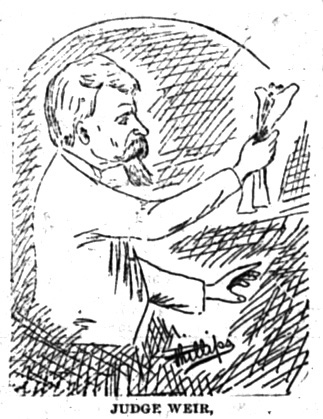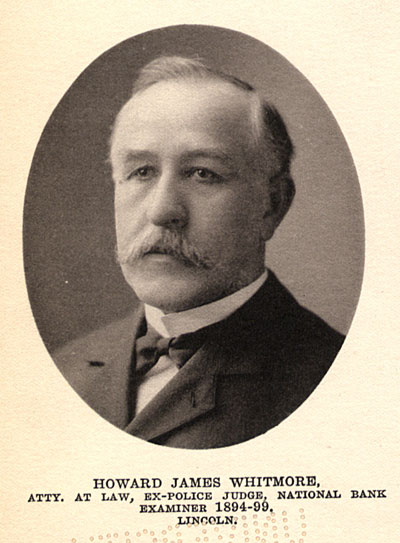Who's Who
- Billingsley, Lorenzo W.
- Brewer, David J.
- Brust, Max
- Bryan, William Jennings
- Burr, Carlos C.
- Burr, Lionel C.
- Cleveland, Grover
- Courtnay, Dominick G.
- Crampton, Peter
- Dawes, Charles Gates
- Deweese, Joel W.
- Dundy, Elmer S.
- Field, Allen W.
- Fitzgerald, John
- Graham, Robert B.
- Hall, Frank M.
- Hardy, Harvey Wesley
- Hart, Charles S.
- Holyoke, Edgar L.
- Hyatt, Albert J.
- Lambertson, Genio M.
- Lewis, Frank W.
- Littlefield, Harrison D.
- Malone, James
- Marquett, Turner M.
- McCool, Horace
- McFarland, Monday
- McReynolds, Robert
- Melick, Samuel M.
- Merrill, George
- Moore, Robert Emmett
- Parker, Charles M.
- Parsons, Albert F.
- Patterson, Jay
- Philpott, James E.
- Quick, Tunis P.
- Sanders, August (Gus)
- Sawyer, Andrew J.
- Sheedy, John
- Sheedy, Mary
- Sheedy, Pat
- Snell, Novia Z.
- Stearns, Royal D.
- Stewart, Myrtle
- Strode, Jesse B.
- Tripp, Ann(a)
- Weir, Austin H.
- Weir, H.W.
- Whedon, Charles O.
- Whitmore, Howard James
Lorenzo W. Billingsley
(Figure 1) (Figure 2)Lorenzo W. Billingsley was a local attorney and politician in Lincoln during the Gilded Age.
In the early 1880s, Billingsley was a partner of Genio Lambertson in the law firm Lamb, Billingsley, and Lambertson. He was an active booster and belonged to both the Lincoln Commercial Club and the Lincoln Board of Trade, the latter of which he served as the chairman of the committee appointed to draft articles of incorporation. Lincoln voters elected him councilman of the second ward on April 7, 1885 and re-elected him two years later.
In the fall of 1887, Billingsley was sent to the Omaha county jail with the rest of the city council and mayor Andrew J. Sawyer after they removed the local police judge and refused to pay the fine levied by United States circuit court judge David J. Brewer. [1]
Twice Billingsley served as Monday McFarland's lawyer. In November of 1889 he assisted James Philpott as the defense counsel when McFarland found himself charged with "stabbing with intent to kill and wound." Again in January 1891, Billingsley, along with Philpott, was appointed to McFarland's case, this time to defend him against the charges of murder and accessory to murder of John Sheedy.
1. Omaha Daily World, 29 November, 1887. [Back to Reference]
David J. Brewer
David J. Brewer was an important national judiciary figure in the United States during the Gilded Age.
Born on June 20, 1837 in Smyrna, Asia Minor to missionary parents, Josiah and Emilia Brewer, David Brewer returned to the United States as a toddler. At the age of fourteen, he entered Wesleyan College where he joined literary and debate societies such as the Peithologian and the Mystical Seven. After two years at Wesleyan he transferred to Yale where his father had graduated and his brother was then attending. After graduating he moved to Albany, New York to spend about a year reading law in the office of his uncle, David Dudley Field, and then entered the Albany Law School where he became a staunch opponent of slavery.
Shortly after graduating from law school in February of 1858, Brewer left New York for Kansas City, Missouri where he briefly practiced law with W. H. Russell. After a short, unsuccessful attempt to find gold at Pike's Peak, he returned to his parents' home in Stockbridge, Massachusetts before moving to Leavenworth, Kansas Territory in November of 1859. Brewer soon settled comfortably into the legal scene in Leavenworth and in 1861 he married Louise R. Langdon. After unsuccessfully running for state legislature as a Republican in the newly created state of Kansas, he was elected to be judge of the county probate court in Leavenworth County. When his term came to an end in 1864, he successfully campaigned to be judge of the first judicial district of Kansas.
Brewer additionally became involved in the education system in Leavenworth. In August of 1865, he became the superintendent of Leavenworth's public schools. When his term as district court judge drew to a close in 1868, he was nominated for county attorney at a Republican county convention on September 26. He won the election handily over Democrat Cole Foster. Following that two-year term, Brewer was elected as associate justice of the Kansas Supreme Court — a position that he retained for fourteen years being re-elected twice, in 1876 and 1882.
Brewer was on the Kansas State Supreme Court when United States President Chester A. Arthur appointed him to the United States of the Eighth Circuit on March 25, 1884. The eighth circuit at the time covered Nebraska, Minnesota, Iowa, Missouri, Kansas, Colorado, Arkansas, North Dakota, South Dakota, and Wyoming. After the death of associate justice Stanley Matthews, President Benjamin Harrison appointed Brewer to the United States Supreme Court in March of 1889. [1]
During his time as a United States circuit court judge in St. Louis Brewer ordered Lincoln mayor Andrew J. Sawyer not to proceed with the blackmail and embezzlement charges against police judge Albert Parsons. When Sawyer ignored this order, Brewer proceeded to charge the mayor and his entire city council with contempt. When they refused to pay the fines, Brewer ordered them to be arrested and placed into jail in Omaha.
1. Michael J. Brodhead, David J. Brewer: The Life of a Supreme Court Justice, 1837-1910 (Carbondale: Southern Illinois University Press, 1994), 2-4,10, 12-16, 22, 52, 72-74. [Back to Reference]
Max Brust
Max Brust, a traveling salesman for the American Tobacco Company in San Francisco, was Mary Sheedy's fourth husband.
Mary left Lincoln in late 1892 to marry Brust. They moved to San Francisco and Brust quit his traveling salesman job to settle down as a storekeeper. Brust lived with Mary in San Francisco into the twentieth century.
William Jennings Bryan
(Figure 3)William Jennings Bryan was perhaps the most well known figure in Gilded Age Lincoln.
Bryan was born in Salem, Illinois on March 19, 1860 to Silas Bryan and Mariah Elizabeth Jennings Bryan. In his youth, he attended both the public schools and the private Whipple Academy in Jacksonville, Illinois. In the 1870s, he enrolled at Illinois College in Jacksonville where he graduated in 1881. While at Whipple Academy and Illinois College, Bryan developed his unique skill for oratory and was active in the Sigma Pi literary society; he additionally became intensely religious. Bryan then decided to enter law school at Union College. He received his law degree in 1883 and returned to Jacksonville to practice law with the firm Kirby, Brown, and Russell.
After visiting a law school friend, Adolphus Talbot, in Lincoln, Nebraska in 1887, Bryan moved to the city in the same year to practice law with Talbot. By 1891 Bryan was one of the most notable lawyers in Lincoln. He additionally played an important role in social organizations such as the the Union Club, the Union Commercial Club, and the Round Table Club, a literary society which he founded with Talbot.
Bryan was a successful member of the Democratic Party as well. Nebraska voters elected him to the Fifty-second Congress in 1890 and re-elected him in 1892; in 1884, however, he declined to run so he could campaign for the United States Senate. He lost and subsequently became chief of the editorial staff at the Omaha World-Herald. He remained politically active though, and was a delegate to the Democratic National Convention five times and a presidential candidate in 1896, 1900, and 1908. His support for free silver and other populist agendas won him the endorsement of the Populist Party and the Silver Republican Party in his first two campaigns.
During the Spanish-American War Bryan raised the Third Regiment Nebraska Volunteer Infantry, of which he became colonel, in May of 1898. Following the war he returned to Lincoln and established The Commoner, a local newspaper journal devoted to advancing causes for populism.
Bryan achieved his greatest political success when President Woodrow Wilson appointed him as his Secretary of State for his first term in office. He served in this position until June 9, 1915 when he resigned to resume his pursuits of lecturing and writing. After removing to Miami, Florida in 1921, Bryan died on July 26, 1925 while acting as an attorney in the Scopes Monkey Trial in Dayton, Tennessee. He is buried in Arlington National Cemetery.
Following the arraignment of Mary Sheedy and Monday McFarland for the murder of John Sheedy, Bryan worked briefly as one of the various lawyers who carried out an investigation of the murder in order to put together a defense strategy and offer services to the accused. In fact, in the days following McFarland's confession, newspaper articles reported that Bryan, along with William L. Cundiff, had been retained by the county court to defend McFarland. The claim, however, was not fulfilled.
1. A.T. Andreas, History of the State of Nebraska. Coletta, Paolo E. William Jennings Bryan Political Evangelist, 1860-1908 (Lincoln, Nebr.: University of Nebraska Press, 1964), 1-20; Sawyer, Lincoln: The Capital City, 757-761; Andrew B. Koszewski, William Jennings Bryan's Law Practice in Nebraska, 1887-1891, Thesis, University of Nebraska, August, 1991, Chapter One. [Back to Reference]
2. Mahoney, "The Great Sheedy Murder Trial," 169; Lincoln Weekly News, 22 January, 1891. [Back to Reference]
Carlos C. Burr
(Figure 4) (Figure 5)Carlos C. Burr was an influential real estate developer, lawyer, booster and political figure in Lincoln during the Gilded Age.
Burr was born August 15, 1846 in Kane County, Illinois. After studying law for three years in the office of Hon. James K. Edsall, he enlisted in the army twice and in September of 1867, was admitted to the Illinois state bar. On June 28, 1868 Burr married Mary D. Smith and that same year they came to Lincoln where he intended to practice law. He was forced to work as a carpenter instead, making some six dollars a week for about a year.
As a real estate developer, Burr was responsible for the erection of thirteen business blocks in Lincoln, including the Burr Block at the corner of Twelfth and O Streets, a project that cost over one hundred twenty-five thousand dollars. He also, along with others, induced the proprietors of the Missouri Pacific Railroad to extend its line to Lincoln.
Burr was an active delegate in city, county, and state Republican conventions; he was elected to Lincoln's first city council in 1871 and was later elected to the state senate in 1874 and 1884 where he initiated the Saline Land Bill. In 1885, Burr won a close (thirty-vote margin) mayoral election in Lincoln against capitalist John Fitzgerald. As mayor, he worked to make municipal improvements such as street lighting for all of Lincoln and better water works and sewerage systems. Burr also served on the board of directors of the Lincoln Board of Trade and was a member of the Union Club.
Although an extremely influential character in Lincoln at the time and admired by the press, Burr did not subscribe to the reformist ethos of many of the city's boosters. Temperance forces in Lincoln often accused him of "standing in with the liquor interests" for he was known to patronize Tunis P. Quick's saloon and owned many racing horses that ran at the fairgrounds. When some local leaders organized the Law and Order League to supplement normal police officers in arresting lawbreakers, he saw little need for it and awarded the normal police officers special caps to show his appreciation for their work. Also, in 1886, as mayor, he supported the election of Albert Parsons to police judge.
Burr, brother of Lincoln attorney Lionel Burr, maintained his law offices in the Burr Block in office number 11 on the first floor. His longtime residence was at 1530 L Street. Burr had four children — Frank S., Bertie O., Grace, and Helen L.
1. Portrait and Biographical Album of Lancaster County, Nebraska (Chicago: Chapman Bros., 1888), 735; A.T. Andreas, History of the State of Nebraska (Chicago: Western Historical Company, 1882), 1060. Fact that Burr won Lincoln mayoral election by thirty votes against Fitzgerald in Andrew J. Sawyer, Lincoln: The Capital City and Lancaster County (Chicago: Clarke Publishing Co., 1916), 30, 32, 153, 156. [Back to Reference]
2. Daily Nebraska State Journal, 23 September, 1876, 15 May 1883, 5, 14, 29 April, 1885, 6 October, 1886; Daily State Democrat, 14 November, 1885, 23 January, 1886; Directory of the City of Lincoln for 1881-1882 (Lincoln: Sam H. Glenn, 1881), 34; Lincoln City Directory (Lincoln: The State Journal Company, 1889), 197; Cherrier's Lincoln City Directory (Lincoln: The State Journal Company, 1890), 152; Hoye's Directory of Lincoln City (Hoye Directory Company, 1891), 101; Hoye's City Directory of Lincoln (Lincoln: State Journal Company, 1892), 106. [Back to Reference]
Related: Spatial Narrative for Carlos C. BurrLionel C. Burr
Lionel Burr was a prominent attorney in Lincoln's two most famous legal battles in the Gilded Age; he was also the brother of Lincoln mayor and booster, Carlos C. Burr.
Lionel Burr was born in July of 1847 in Dixon, Illinois and lived there until he entered the army in December of 1862. Burr married Aldana Giles of New Hampton, New Hampshire on October 12, 1868 in Dixon and three years later moved to Winona, Minnesota where he began reading law.
In October of 1872, Burr came to Lincoln and commenced his law practice, partnering with Stephen Pound, the father of both Roscoe and Louise Pound. Burr also belonged to many social organizations in Lincoln including the Union Club which became the Union Commercial Club after its merger with the Lincoln Commercial Club in 1897.
In 1887, Burr played a crucial role in the incarceration of Mayor Andrew J. Sawyer and the city council. As police judge Albert Parsons' attorney, he went before Federal District Judge David J. Brewer in St. Louis to present a bill of equity that claimed that Parsons' right to due process had been violated by a "conspiracy" of gamblers and reformist council members who were trying to remove him from office.
In May of 1891 Burr was a witness for the defense during Mary Sheedy and Monday McFarland's trial. On the stand he stated that Hyman Goldwater, the pawnshop owner who claimed McFarland bought the cane from his shop, had told him that he was offered a reward for his testimony and that he wanted to know what he could do to force the collection of payment because he had not received it.
1. A. T. Andreas, History of the State of Nebraska. [Back to Reference]
2. Omaha Bee Morning Edition, 23 May, 1891. [Back to Reference]
Grover Cleveland
Grover Cleveland served two non-consecutive terms as president of the United States.
As a reformist in New York, Cleveland's political rise took place over a short period of just four years. He was elected mayor of Buffalo, New York in 1881, governor of New York a year later, and was inaugurated as the president of the United States in 1885. He served his second term as president from 1893-1897.
Cleveland became involved in the incarceration of Lincoln's mayor and city council in the fall of 1887 when supporters of Mayor Andrew J. Sawyer, including Nebraska's governor, John Thayer, and judges on the state supreme court and the district court, signed a petition asking President Cleveland for an unconditional pardon. That December, Sawyer went to Washington, D.C. to await the decision of the United States Supreme Court as to whether or not district judge David J. Brewer had overstepped his jurisdiction by declaring Sawyer and the city council in contempt of court for their removal of police judge Albert Parsons. During this time he met with President Cleveland to discuss the "particulars" of the case, and although Cleveland expressed his support, the presidential pardon was not needed as the Supreme Court ruled in favor of Sawyer and the city council.
1. Andrew J. Sawyer, Lincoln: The Capital City, Volume I, 290, 292. [Back to Reference]
Dominick G. Courtnay
Dominick Courtnay was a prominent attorney in Lincoln during the Gilded Age.
Courtnay was born in New York City on October 8, 1853 and lived there until he moved to Belvidere, Illinois at the age of thirteen. While living in Belvidere, Courtnay received a degree from Beloit College in Beloit, Wisconsin. He then read law with Charles E. Fuller in Belvidere. In the fall of 1877 he came to Lincoln, Nebraska where he became an attorney. Courtnay married Martha Irene Atkins, a native of Canada, in September of 1878.
In 1886 Courtnay was a candidate for the state legislature. As a lawyer, he defended many owners of gambling halls and saloons in court when reformers began to bring charges against them in Lincoln. He acted as August Sanders' attorney when the Lincoln Law and Order League targeted Sanders in 1886 for operating a gambling establishment. In 1887 Courtnay was one of Albert Parsons' lawyers, along with Lionel C. Burr, who argued before the Lincoln city council that the charges of embezzlement and blackmail against Parsons were brought forward "to maintain the rule of bad characters" in the city; he called the evidence fraudulent and questioned the authority of the city council to remove Parsons from office.
Courtnay, who was present at the Sheedy house just after the assault, became involved in the legal affairs after John Sheedy's murder as a representative of the heirs of Sheedy's estate. He additionally testified at Mary Sheedy and Monday McFarland's trial that John Sheedy had come to his office in the Richards Block at 1029 O Street a few days before the assault to show him a letter that threatened to kill him if he refused to stop his opposition to other gamblers in Lincoln. A couple of weeks following the trial, Courtnay claimed that Charley Crowe had searched his office in an unsuccessful attempt to find John Sheedy's will. After Crowe had been left alone in the building, he had returned to his office to find papers about the room and his safe ransacked.
Courtnay's long-time residence was at 1811 L Street.
1. A. T. Andreas, History of the State of Nebraska (Chicago: Western Historical Company, 1882). [Back to Reference]
2. Mahoney, "The Great Sheedy Murder Trial," 174; Daily Nebraska State Journal, 10 August, 1886; Lincoln Weekly News, 22 January, 5 February, 11 June, 1891; Directory of the City of Lincoln for 1881-1882 (Lincoln: Sam H. Glenn, 1881), 48-49; Lincoln City Directory (Lincoln: The State Journal Company, 1889), 221; Cherrier's Lincoln City Directory (Lincoln: The State Journal Company, 1890), 162; Hoye's Directory of Lincoln City (Hoye Directory Company, 1891), 129; Hoye's City Directory of Lincoln (Lincoln: State Journal Company, 1892), 139. [Back to Reference]
Peter Crampton
Peter Crampton was a barber whose father employed Monday McFarland at the time of John Sheedy's murder.
Crampton testified at Mary Sheedy and Monday McFarland's trial, confirming McFarland's employment at his father's shop, and stating that the day before the murder, McFarland had been called to Sheedy's residence by John and stayed there for over two hours.
1. Lincoln Weekly News, 21 May, 1891; Omaha Bee Morning Edition, 16 May, 1891; Directory of the City of Lincoln for 1881-1882 (Lincoln: Sam H. Glenn, 1881), 124; Lincoln City Directory (Lincoln: The State Journal Company, 1889), 379; Cherrier's Lincoln City Directory (Lincoln: The State Journal Company, 1890), 219; Hoye's Directory of Lincoln City (Hoye Directory Company, 1891), 314; Hoye's City Directory of Lincoln (Lincoln: State Journal Company, 1892), 359 [Back to Reference]
Charles Gates Dawes
Charles Gates Dawes was one of the most recognized names in Lincoln during the Gilded Age.
Dawes was born and educated in Marietta, Ohio. After attending Marietta College and receiving his law degree from the University of Cincinnati in June of 1886 at the age of twenty-one, Dawes arrived in Lincoln on April 25, 1887 to launch his law and business career. Although he started out without much money or influence, Dawes became a successful attorney and businessman and developed relationships with many of the city's most prominent men, including William Jennings Bryan, John Fitzgerald, John J. Pershing, and A. S. and I. M. Raymond.
As an aspiring businessman, Dawes first placed his eyes on real estate development in West Lincoln. By 1890, he had organized the Dawes Business Block Company and controlled around nine or ten business blocks in the downtown district. He also became involved in the banking, energy, and meat packing businesses. Socially, Dawes was a member of Lincoln's most powerful organizations including the Round Table Club and the "Patriarchs."
The day the "not-guilty" verdicts in the Mary Sheedy and Monday McFarland trial were announced, Dawes wrote to his friend J. D. Cox telling him, not about the verdicts, but instead about the scrabble for fees among the lawyers involved. He wrote that he had heard that H. W. Weir had objected to the proposed fee of $15,000 and "lopped off $2,500" to give only $12,500 to Stearns and Strode. He also mentioned that he had gotten involved in the case when Weir had asked him to research Sheedy's real estate holdings because Weir suspected he would "have to take out a mortgage for his fee." The estate, Dawes informed Wier, was only worth $54,500. Dawes wrote that he thought Weir was "an able and genial gentleman," who had "a tough client in Mrs. Sheedy."
In January of 1895, Dawes ventured to Chicago in hopes of "making an increase in... property and income." Two weeks after relocating, he met M. A. Hanna, the head of the Republican Party, and soon found himself in charge of William McKinley's presidential campaign in Illinois which lead to an eventual move to Washington D. C. and many years spent working in the political realm. Throughout this time, however, Dawes remained involved in business and banking endeavors, for which he was best known. Among his accolades was the role of president of the Central Trust Company of Illinois in Chicago from its conception in 1902 until 1917.
In 1889, Dawes maintained his law office in room 39 of the Burr Block and lived at 1344 J Street. At the time of the Sheedy murder, Dawes worked at the law firm Dawes & Coffroth located in the Dawes Business Block Company at 131 South Twelfth Street with A. Bruce Coffroth.
1. Bascom N. Timmons, A Journal of the McKinley Years By Charles G. Dawes (Chicago: The Lakeside Press, 1950), v-xx; "Charles G. Dawes, A Nebraska Businessman, 1887-1894: The Making of An Entrepreneur, Nebraska History, Volume 46, September 1965, 193-207. [Back to Reference]
2. Mahoney, "The Great Sheedy Murder Trial," 178; Charles Gates Dawes Diary, May 30, June 1, 1891; Dawes to J. D. Cox, May 29, 1891, Charles Gates Dawes Papers, Northwestern University. [Back to Reference]
3. Lincoln City Directory (Lincoln: The State Journal Company, 1889), 230; Cherrier's Lincoln City Directory (Lincoln: The State Journal Company, 1890), ; Hoye's Directory of Lincoln City (Hoye Directory Company, 1891), 139; Hoye's City Directory of Lincoln (Lincoln: State Journal Company, 1892), [Back to Reference]
Related: Spatial Narrative for Charles Gates DawesJoel Deweese
Joel Deweese was a successful attorney in Lincoln through the last decades of the nineteenth century. He was born in Morgan County, Illinois on September 10, 1846. When he was six months old, Deweese's family moved to Marion County, Iowa where his father would build the first log cabin in Pella, Iowa. On August 15, 1862 Deweese enlisted as a private in Company G, 23rd Iowa Volunteer Infantry and served until August 15, 1865. He was Sergeant of Company G when he was mustered out. Deweese attended Central University in Pella and then the law school at Iowa City. In 1868, he was admitted to the bar and began practicing law in Prairie City. Deweese married Rebecca Ryan, a native of Washington County, New Yorkin November of 1869. While in Iowa, he served two terms in the Iowa state legislature as a representative from Jasper County.
Shortly after his March 1879 arrival in Lincoln, Deweese became associated with Turner M. Marquett, leader of the Law and Order League. The two attorneys joined with Frank Hall, one of the prosecuting attorneys in the Sheedy trial, to form the law firm of Marquett, Deweese, and Hall. Deweese was accepted into the Union Club in May of 1883.
1. A. T. Andreas, The History of the State of Nebraska (Chicago: Western Historical Company, 1882). [Back to Reference]
Elmer S. Dundy
Elmer S. Dundy was a prominent lawyer and judge who arrived in Nebraska early in its history. As a district court judge, Elmer Dundy became involved in the Lincoln City Council scandal of 1887.
Dundy was born in Trumbull County, Ohio, on March 5, 1830. When he was around twenty years old his family moved to Clearfield County, Pennsylvania where he taught at the public schools and eventually became principal of the schools. Like many of his contemporaries, Dundy studied law while teaching and was admitted to the Clearfield County Bar in 1853.
In 1857, Dundy ventured to Nebraska, living initially in Nebraska City and soon after moving to Archer. That same year, after a re-survey of the western line of the Half Breed Reserve put Archer off the Government Land, Dundy moved to Falls City, two miles southwest of Archer, and began a successful law firm.
Dundy served as a member of the Council of the Territorial Assembly in 1859 and was elected as a member of the Nebraska Legislature in 1860. In 1863 President Abraham Lincoln appointed Dundy as associate justice of the Supreme Court of Nebraska for the half of the state below the Platte River. He was also a member of the Union Club.
Dundy married Mary Robertson of Omaha with whom he had four children, one who died in infancy. Dundy's only son, Elmer S., Jr., moved to New York City and helped found the New York Hippodrome and Luna Park. Dundy, Sr. died on October 28, 1896 in Falls City; he was later recognized with a county (or rather a section of a county) in western Nebraska named after him.
1. Judge Elmer S. Dundy Biographical Sketch, Elmer S. Dundy Papers, NSHS [Back to Reference]
2. Sawyer, Lincoln, Volume I. [Back to Reference]
Allen W. Field
(Figure 6) (Figure 7)Allen W. Field, a Lincoln booster, was an attorney and district court judge of Lancaster County during the Gilded Age.
Field was born in La Salle, Illinois on November 20, 1853; his family settled in Nebraska in the 1860s. Field received both his undergraduate and his Master of Arts degrees from the University of Nebraska. After completing his college work, he began the study of law in the office of James E. Philpott and was admitted to the bar in 1878. That same year he became justice of the peace and in January of 1879 he formed a law partnership with Edwin P. Holmes (later judge of the district court).
Field was a leader in establishing the Republican party in Nebraska. In 1882, he was elected as a state representative and was re-elected in 1884 (and became speaker of the house). In 1886 he was appointed judge of the district court of Lancaster County; he was elected to the same position the following year and again in 1891. In 1892, Field resigned in order to run for congress; he lost to William Jennings Bryan by one hundred and forty votes.
As the district court judge during the trial of Mary Sheedy and Monday McFarland in 1891, Field ruled to admit McFarland's confession as evidence against him but not against Mary Sheedy. He also reminded the jury before their deliberation that although the defendants were being tried together they should consider the cases separately.
As a booster, Field had leading roles in the Union Club and the Union Commercial Club; he was also a member of the Congregational church and many fraternal orders such as the Knights of Pythias, the Masons, the Mystic Shrine, and the Ancient Order of United Workmen. Additionally, as the president of the University of Nebraska Alumni Association, he provided financial and vocal support to keep the University in its present location when an effort was made in 1914 and 1915 to move it to the state farm site (currently the University of Nebraska-Lincoln East Campus).
On December 20, 1883, Field married May B. Fairfield (whose father was for a time chancellor of the University of Nebraska); they had four children. At the time of his death on June 9, 1915, he was a member of the law firm Field, Ricketts & Ricketts.
In the early 1880s, before building his large house at 544 South Seventeenth Street, Field boarded at both the Clifton House and a house at 1828 N Street.
1. Andrew J. Sawyer, Lincoln, Volume II, 18-20; Sawyer, Lincoln, Volume I, 32, 164; Nebraskans (1904), 58. [Back to Reference]
2. Daily Nebraska State Journal, 4 November, 1885; Mahoney, "The Great Sheedy Murder Trial," 174, 176. Directory of the City of Lincoln for 1881-1882 (Lincoln: Sam H. Glenn, 1881), 64; Lincoln City Directory (Lincoln: The State Journal Company, 1889), 252; Cherrier's Lincoln City Directory (Lincoln: The State Journal Company, 1890), 172; Hoye's Directory of Lincoln City (Hoye Directory Company, 1891), 168; Hoye's City Directory of Lincoln (Lincoln: State Journal Company, 1892), 184; "Nebraska Stock Yard Company, List of Stockholdes and Number of Shares Held by Each," Nebraska Stock Yard Papers, MS3988, S1F1, NSHS. [Back to Reference]
John Fitzgerald
(Figure 8) (Figure 9) (Figure 10) (Figure 11) (Figure 12)John Fitzgerald was a prominent Lincoln capitalist in the Gilded Age.
After moving to Lincoln in 1878, Fitzgerald played a significant role in the development of the city's economy through railroad contracting, agricultural endeavors, banking, and other business ventures. He served as the president of the First National Bank and was a leading member of the Lincoln Board of Trade, serving on committees in the group that sought to expand manufacturing and bring more railroads to Lincoln.
Fitzgerald, a Democrat with reformist political ambitions, ran a mayoral campaign against Carlos C. Burr and prohibitionist Harvey Wesley Hardy in 1885. After losing to Burr by thirty votes, Fitzgerald, believing that the election had been stolen, protested the ratification of the vote by the city council through his lawyers Charles O. Whedon, Andrew J. Sawyer, and Novia Snell.
Fitzgerald was also an active temperance and moral reformer in Lincoln. In January of 1887, the Lincoln Law and Order League elected him to the executive committee with Charles H. Gere, Frank Lewis, Andrew Sawyer, A. S. Raymond, John R. Clark, and John McConniff. In addition, Fitzgerald was an active member of the Irish League of America and served as its president from 1886 until 1890.
As a reformer and fellow real estate developer, Fitzgerald was a long-time political and business adversary of John Sheedy. Following Sheedy's murder, Fitzgerald was appointed as a co-administrator of Sheedy's estate along with Mary Sheedy.
1. A.T. Andreas, History of the State of Nebraska (Chicago: Western Historical Co., 1882), 1065; Portrait and Biographical Album of Lancaster County, Nebraska (Chicago: 1888), 791. [Back to Reference]
2. Fitzgerald v. Fitgerald & Mallory Construction Co., (Neb. 1894) 59 N.W. 838, 41 Neb. 374; Fitzgerald et al. V. Benadom (Neb. 1892) 53 N.W. 72, 35 Neb. 317; Fitzgerald v. Fitzgerald & Mallory Construction Co. (Neb. 1895) 62 N.W. 899, 44 Neb. 463; Daily Nebraska State Journal, 30 December, 1888; Daily Nebraska State Journal, 20, 24 August, 1886, 25 January, 1887, 31 December, 1894; Nebraska Stock Yards Paper, NSHS. [Back to Reference]
Related: Spatial Narrative for John FitzgeraldRobert B. Graham
Robert B. Graham was the mayor of Lincoln when John Sheedy was killed in 1891.
Born to Robert and Anna Graham in Carlisle, England in November of 1851, Graham was reared and educated in his native country until 1881. He then immigrated to the United States, came to Lancaster County immediately, and began work as a farm hand. Graham later began his own farm and by 1916, he owned eighty acres of land on Section 23 in the Lancaster precinct; he was known as a skillful and practical farmer.
Graham was active both socially and politically in Lincoln. He was a member of the Episcopal Church, the Union Club, and the Modern Woodmen of America. Voters elected Graham, a Democrat, as their mayor in April of 1889, but he was unsuccessful in his campaign against the incumbent mayor, Austin H. Weir, in 1893.
As mayor, Graham was amongst the Lincolnites crowding the jury room at the courthouse during the coroner's inquest for the Sheedy murder case. After Monday McFarland made his first confession to detective James Malone, Graham was brought in to the city jail, along with Marshal Samuel Melick and a stenographer, to hear a full, detailed confession. Some members of the press later accused Graham of trying to use the Sheedy trial to his advantage by pushing for a guilty verdict against Mary Sheedy and McFarland.
Graham's first wife, the mother of his first two children, died in 1881. In October of 1896 Graham re-married to Mary (McKnight) Parrish, daughter of Irish immigrants Michael and Anna McKnight from New York state.
Graham lived at 1332 L Street.
1. Andrew J. Sawyer, ed., Lincoln, Volume II, 720-721, Volume I, 31, 32, 157158. [Back to Reference]
2. Mahoney, "The Great Sheedy Murder Trial," 164; Union Club Minutes, RG2999, NSHS; Lincoln City Directory (Lincoln: The State Journal Company, 1889), 273; Cherrier's Lincoln City Directory (Lincoln: The State Journal Company, 1890), 180; Hoye's Directory of Lincoln City (Hoye Directory Company, 1891), 193; Hoye's City Directory of Lincoln (Lincoln: State Journal Company, 1892), 211. [Back to Reference]
Frank Hall
(Figure 13)Frank Hall was an eminent attorney and booster in Lincoln from the 1870s until the 1930s.
Hall was born on January 27, 1852 in Morgan County, Illinois. He moved to Nebraska in 1871 and attended the State Normal School in Peru, Nebraska. He was admitted to the Nebraska bar in 1880 and became a partner in the law firm of Marquett, Deweese, and Hall with Burlington Railroad attorney, Turner M. Marquett, and Joel Deweese. In the early twentieth century, Hall was a member of the law firm Hall, Woods, and Pound with Frank Woods and Roscoe Pound.
An active booster, Hall belonged to the Union Club and the Lincoln Commercial Club, which became the Union Commerical Club when the two organizations merged in 1897. He was also an avid art collector and the president and founder of the Nebraska Art Association; his art collection has been housed at the Sheldon Memorial Art Gallery in Lincoln since 1963. Hall's other lasting contribution to the arts was his 1909 work in securing New York artist Daniel Chester French to sculpt a statue of Abraham Lincoln to be placed on the west side of the State Capitol building. French's ability to represent Lincoln led to his selection for completing the Lincoln Memorial in Washington, D. C..
In 1891 Hall was hired by Dennis Sheedy to be a prosecuting attorney in the trial accusing Mary Sheedy and Monday McFarland of his brother John's murder. He was also hired by John Fitzgerald to assist in the dealings of Sheedy's estate when Fitzgerald was named co-administrator along with Mary Sheedy.
1. Sara Mullin Baldwin, ed., Who's Who in Lincoln: Biographical Sketches of Men and Women of Achievement (Lincoln: Robert M. Baldwin, 1928), 106. [Back to Reference]
2. Lincoln Weekly News, 19 March, 1891. [Back to Reference]
Related: Spatial Narrative for Frank HallHarvey Wesley Hardy
Harvey Wesley Hardy was one of Lincoln's pioneer merchants as well as a prominent activist for social and political reform.
Born in Wyoming County, New York in 1825, Hardy settled in Lincoln in 1871 and began a furniture store that survived well into the twentieth century. In 1877, Lincoln voters elected Hardy, a Republican at the time, as their mayor and as such he originated a high-license ordinance that increased the fee saloon operators paid for one year to one thousand dollars; he was re-elected in 1878. Hardy also served on the Lincoln school board for several years and was an advocate for educational improvements.
In time, Hardy's political affiliations shifted and in 1885, running as the prohibitionist candidate, he challenged John Fitzgerald and Carlos C. Burr in the Lincoln mayoral election. Lincoln voters, however, held his views to be "a little off color politically" at the time and he came in a distant third place with only two hundred and forty-seven votes. In 1886, he was the prohibition candidate for the governor of Nebraska.
Hardy also had a proclivity to write; he contributed many letters to the editor in the local newspapers in Lincoln and edited the state weekly temperance periodical, The New Republic. He maintained a deep distrust of Eastern businessmen, referring often in his writings to the number of millionaires in the East compared to those in the West. Hardy, with his reformist ideology bordering on socialism, advocated government ownership of railroads, coal mines, and oil refineries.
Hardy died in 1913 at the age of eighty-eight.
1. Andrew J. Sawyer, ed., [Back to Reference]
2. Harvey Wesley Hardy Papers, NSHS. [Back to Reference]
C. S. Hart
Charles S. Hart was a physician in Lincoln who was born and raised in Ohio.
Hart attended medical school in Columbus, Ohio and came to Lincoln after living in Marietta, Ohio for some time. At the time of Sheedy's assault, Hart was a block away at the Capitol Hotel on the corner of Eleventh and P streets. He heard gunshots and rushed to the Sheedy residence. He, along with Doctor Everett, dressed Sheedy's head wound and returned to the house throughout the night to check on the patient. Hart was present at the home with Mary Sheedy and her brother-in-law, Dennis Sheedy, when Sheedy began breathing heavy and fell into an unconscious state around four or five o'clock in the morning.
At Mary Sheedy and Monday McFarland's trial, the physicians disagreed as to what was the cause of death — the blow to the head by the cane or the alleged use of morphine. Hart, unlike some of the other physicians present at the autopsy (such as Doctor Beachly and Doctor Winnet who believed that morphine killed Sheedy), testified that the death was most likely caused by the strike to the head with the leather-covered steel cane, not by morphine, thereby implicating McFarland for the murder.
Hart lived at 1928 J Street.
1. Lincoln Semi-Weekly State Journal, 23 January, 1891, 15 May, 1891, Lincoln Weekly News, 29 January, 5 February, 14 May, 1891. [Back to Reference]
Edgar L. Holyoke
Edgar L. Holyoke was a Lincoln physician who was the county coroner in 1891.
Following Sheedy's murder Holyoke assembled a coroner's jury consisting of George Bosselman, T. C. Munger, Frank R. Waters, James Aitkin, W. G. Mead, and Robert McReynolds. At the suggestion of McReynolds, Holyoke called for the coroner's inquest to be held privately, the first such instance in Lincoln's history.
As the county coroner Holyoke was also responsible for directing a team of physicians, including Doctors Casebeer, Hart, Everett, Mitchell, Beachly, and Winnett to conduct Sheedy's autopsy at which a group of newspaper reporters were also present.
1. Lincoln Weekly News, 15, 22 January, 1891; Daily Nebraska State Journal, 13 January, 1891; Semi-Weekly State Journal, [Back to Reference]
A.J. Hyatt
Albert J. Hyatt was a police officer and captain in Lincoln in the 1870s and 1880s who subscribed to the "traditional" booster ethos as opposed to the Law and Order ethos of Samuel Melick and James Malone.
Hyatt was born in August of 1844 in Monroe County, New York and was raised and educated in Rochester, New York. In the early 1860s, he went to Pennsylvania to speculate in the oil regions and later went to mine in Montana. In 1868, he returned to Pennsylvania to engage in business and in 1870 he went back to Rochester to engage in farming. Hyatt married Mary A. Crane of Rochester in March of 1871; they had four children.
In 1872 Hyatt came to Lincoln, Nebraska where he soon became involved in well digging. He dug and completed the artesian well that was located in the post office square. Hyatt was a member of the Presbyterian Church and served as a detective on the police force; he was appointed as the captain of the force in 1878. As a detective, he often frequented Tunis P. Quick's saloon. Hyatt was present with John Sheedy when Sheedy filed a citizen's petition against police judge Albert Parsons, charging him with embezzlement and blackmail.
Hyatt lived at 1336 M Street.
1. A. T. Andreas, History of the State of Nebraska. [Back to Reference]
Genio M. Lambertson
(Figure 14)Genio M. Lambertson was a prominent Lincoln attorney and reformist during the Gilded Age.
Lambertson was born on May 19, 1850 and lived in Franklin, Indiana until 1874 when he moved to Lincoln, Nebraska to practice law. Early in his career Lambertson was law partners with Walter J. Lamb, the president of the Lancaster County Bank, and Lorenzo W. Billingsley in the firm Lamb, Billingsley, and Lambertson. In December of 1878, Lambertson was appointed United States Attorney; he later gained national attention as an attorney when he served on the counsel for Mayor Andrew J. Sawyer and the city council, along with Lionel C. Burr, when the mayor and council were charged with contempt in a federal district court.
Lambertson was a supporter of the Republican party as early as the 1870s and became a member of the Union Club on August 24, 1895. He was also a member of the Lincoln Commercial Club and owner of a small amount of stock in the Nebraska Stock Yard Company. On June 10, 1880, Lambertson married Jane Gundry of Mineral Point, Wisconsin.
Hired by Dennis Sheedy, Lambertson, along with Frank M. Hall, assisted county attorney Novia Z. Snell in prosecuting Mary Sheedy and Monday McFarland for the murder of John Sheedy in 1891.
Lambertson maintained his office in the Burr Block in rooms 55 and 56 through most of his career. His residence was at 344 N. Fourteenth Street until around 1892 when he moved into a house at 1119 H Street.
1. A. T. Andreas, History of the State of Nebraska (Chicago: Western Historical Company, 1882). [Back to Reference]
2. Andrew J. Sawyer, "History of the Incarceration of the Lincoln City Council," Proceedings and Collections of the Nebraska State Historical Society, 10 (1902): 105-137; Directory of the City of Lincoln for 1881-1882 (Lincoln: Sam H. Glenn, 1881), 105-106; Lincoln City Directory (Lincoln: The State Journal Company, 1889), 334; Cherrier's Lincoln City Directory (Lincoln: The State Journal Company, 1890), 201; Hoye's Directory of Lincoln City (Hoye Directory Company, 1891), 261; Hoye's City Directory of Lincoln (Lincoln: State Journal Company, 1892), 296; "Nebraska Stock Yard Company, List of Stockholdes and Number of Shares Held by Each," Nebraska Stock Yard Papers, MS3988, S1F1, NSHS. [Back to Reference]
Related: Spatial Narrative for Genio M. LambertsonFrank W. Lewis
Frank W. Lewis was an attorney and financial agent who became a devoted member of Lincoln's reformists wishing to eliminate the influence of alcohol, gambling, and prostitution in the city. He ran an unsuccessful campaign for county attorney against Royal D. Stearns in November of 1886.
Lewis worked for many years with his brother, Henry E. Lewis (president of Lincoln Savings Bank and Safe Deposit Co.), in the firm Lewis & Lewis at 109 S. Tenth Street. He was perhaps most widely known, however, for his affiliation with the Lincoln Law and Order League. He was an early supporter who signed the call in early November of 1885 for Nebraska citizens to come together for the purpose of forming a state Law and Order League. When prominent Lincolnites met at the Commercial Hotel on November 12 to begin discussing the formation of the organization, Lewis was chosen secretary of the meeting and was subsequently assigned to a committee (along with T. H. Leavitt, C. H. Gere, I. M. Raymond, reporter Walter Hoge, former mayor John Doolittle, and Postmaster Watkins) that was to make arrangements for the public meeting held the next evening at Temple Hall at the University. Lewis was subsequently elected the permanent secretary of the Lincoln Law and Order League at the November 13 meeting and soon became the group's primary prosecuting attorney, a position he held until the group disbanded sometime in the late 1880s. His first case was against local gamblers (including John Sheedy and August Sanders). At the Law and Order League's first annual meeting in January of 1887, Lewis was placed on the executive committee.
Lewis lived at 265 S. Twenty-Seventh Street until around 1891 when he moved to 305 S. Twenty-Seventh Street.
1. Andrew J. Sawyer, Lincoln, Volume I, 32. [Back to Reference]
2. Daily Nebraska State Journal, 4, 13, 14 November, 1886, 21, 22 January, 2, 3, 4, 5, 23 February, 7 August, 18 November, 1886, 25 January, 1887; Lincoln Weekly News, 14 November, 1885; Lincoln City Directory (Lincoln: The State Journal Company, 1889), 341; Cherrier's Lincoln City Directory (Lincoln: The State Journal Company, 1890), 204; Hoye's Directory of Lincoln City (Hoye Directory Company, 1891), 305; Hoye's City Directory of Lincoln (Lincoln: State Journal Company, 1892), 305. [Back to Reference]
Harrison D. Littlefield
Harrison D. Littlefield was a police officer who worked strictly for the Lincoln Law and Order League.
In December of 1885, members of the League, led by Andrew J. Sawyer, appeared before the city council requesting that they be allowed to nominate a policeman who would serve the ogranization for six months and be paid by the city as were other police officers. The council granted the request and Sawyer proceeded to nominate Littlefield for the position.
As the police officer for the League, Littlefield gathered evidence convicting lawbreaking proprietors and filed complaints against them in the county court. In this he and his prosecuting attorney, Frank Lewis, were quite successful. They brought cases against John Sheedy, August Sanders, other saloonkeepers and gamblers, and the madams and workers in "houses of ill-fame."
In the summer of 1886 Mayor Carlos C. Burr removed Littlefield from the police force. For the following two months Littlefield remained a private officer of the Law and Order League but did not receive any compensation from city funds. In July of 1886 Littlefield was attacked in the courtroom while prosecuting a saloonkeeper; he soon thereafter resigned from the Law and Order League and left Lincoln.
1. Daily Nebraska State Journal, 8 December, 1885, 21, 26 January, 2, 3, 4, 13, 14 February, 1886, 25 January, 1887. [Back to Reference]
James Malone
(Figure 15) (Figure 16)James Malone was a long-time figure of law enforcement in Lincoln.
Malone, born in 1852, was a native of Peoria, Illinois. In 1884 or 1885, he moved to Lincoln and worked as a hackman for Granville Ensign's baggage line. He later joined the police force for a year and then worked as a detective for the Burlington and Missouri River Railroad.
As a dective in the Lincoln municipal police force at the time of the Sheedy murder in 1891, Malone, along with two doctors and officers Kinney, Otto, and Adams, arrived at Sheedy's residence Sunday evening, January 11, after hearing a revolver fired in the street. After Sheedy's death, Malone, along with city marshal Samuel Melick arrested Monday McFarland for the crime. Malone was chiefly responsible for interrogating McFarland, for which his tactics were later questioned. He was accused of not only threatening to turn McFarland over to a lynch mob, but also of promising immunity if McFarland just confessed to the murder.
Malone went on to achieve much prominence in Lincoln as the chief of police; at the time of his death, he was serving his third term as such. He also served many years as the chief special agent for the Burlington and Missouri River Railroad and assisted the Nebraska Bankers Association in their long-time battle against bank robbers. Malone developed new criminal foes in this position, the most noted being gang leader "Shorty" Gray who orchestrated bank robberies in Oklahoma, Kansas, and Nebraska. Around 1910, Malone arrested Gray and some of his gang on a small island near Grand Island, Nebraska after chasing them for nearly a week. In 1913, Gray escaped, killing four prison guards in the process, but Malone again tracked him down, leading Gray to commit suicide.
Malone first resided in Stover's boarding house, but soon after moved into a room on the second floor of the building at 242 North Tenth Street, just one block north of the Quick Building, where he still lived at the time of Sheedy's murder. The police headquarters, where he most likely spent much time, were located at the corner of North Tenth and Q streets, nearby his residence.
1. Lincoln Semi-Weekly State Journal, 16 January, 1891; Lincoln Weekly News, 22 January, 1891; Lincoln Star, 11 December, 1891. [Back to Reference]
2. Charles I. Barker's Lincoln City Directory of 1885 and 1886 (Lincoln: State Journal Company, 1884), 108; Lincoln City Directory (Lincoln: The State Journal Company, 1889), 352; Cherrier's Lincoln City Directory (Lincoln: The State Journal Company, [Back to Reference]
Related: Spatial Narrative for James MaloneTurner Marquett
(Figure 17)Turner Marquett was one of the most successful attorneys in Nebraska's early history.
Marquett was born in Springfield, Ohio on July 9, 1831. At the age of twenty, he attended Ohio University in Athens and after his graduation, immediately went to Kansas and then Iowa where he was admitted to the bar in 1856. Later that year he moved to Plattsmouth, Nebraska where he attained a clerkship in the store of William Slaughter that he worked until he was admitted to the Nebraska bar in 1857.
After he began practicing law in Plattsmouth, Marquett was elected to the territorial legislature, in which he served for three terms, and for four years was the council of the territory. As a stalwart Republican, Marquett played an influential part in the politics of his party in Nebraska, and he was elected as the Republican candidate for congress in June of 1866. His "pre-statehood" term, however, lasted only two days and three nights.
Marquett left Plattsmouth for Lincoln in 1874 and soon afterward formed a law partnership with Amasa Cobb. The firm continued under the name of Cobb & Marquett until 1878 when it was changed to Cobb, Marquett & Moore. After Cobb was appointed judge of the Supreme Court, Marquett formed the firm of Marquett, Deweese, and Hall. In addition to his private practice, he was the general attorney for the Burlington Railroad west of the Mississippi River from the time that railroad came to Nebraska until the time of his death.
Marquett also used his legal influence to advocate reform in politics and society. He became one of many vice presidents of the Law and Order League at its formation in November of 1885, and when Andrew J. Sawyer ran for mayor of Lincoln in January of 1887, Marquett succeeded him as president of the League. During the time of his partnership with Deweese and Hall, Marquett was hired as the attorney of John Fitzgerald, the man named co-administrator of the Sheedy estate after John Sheedy's wife, Mary, was acquitted for her husband's murder in 1891.
Marquett married Harriet Border, a native of Illinois, in November of 1861 and had four children. After she died in June of 1883, Marquett married a second time in 1885 to Asenath Stetson; they lived at the corner of Eighteenth and P streets for many years.
1. Lincoln: The Capital City and Lancaster County, Nebraska, Volume II (Chicago: The S.J. Clarke Publishing Co.,1916), 756-757; Portrait and Biographical Album of Lancaster County, Nebraska (Chicago: Chapman Bros., 1888), 145-147; A.T. Andreas, History of the State of Nebraska (Chicago: Western Historical Co., 1882), 1072; Nebraskans, 57. [Back to Reference]
2. Daily Nebraska State Journal, 25 January, 1887. [Back to Reference]
Horace McCool
Horace McCool was Mary Sheedy's first husband.
McCool married Mary Sheedy, who at the time was known as Mary Gabriel, when she was a young women living in Abingdon, Illinois. Although Mary "was forced to leave him" soon after their marriage, she continued liaisons with McCool for many years, and reportedly sent him money that she had received from her third husband, John Sheedy. McCool allegedly used some of the money to buy a suit in which to marry his second wife.
In the late 1880s, McCool was sentenced to three years in Joliet's state penitentiary for foraging his uncle's signature for credit.
1. Semi-Weekly State Journal, 23 January, 1891; Mahoney, "The Great Sheedy Murder Trial," 165. [Back to Reference]
Monday McFarland
(Figure 18) (Figure 19) (Figure 20)Monday McFarland was an African-American barber who worked in many different barbershops in Lincoln's downtown district. When John Sheedy was murdered in 1891, McFarland became the primary suspect in the case.
As the Sheedys' barber, McFarland made regular house calls to their residence to wash and style the hair of Mary Sheedy. During these visits, Mary and McFarland became intimate, and as one local newspaper speculated, he was "more than a common African hair dresser" to her; allegedly a sexual relationship developed despite McFarland's reference to John Sheedy as his "best friend."
The Saturday after the murder, detective James Malone and city marshal Samuel Melick arrested McFarland at an O Street saloon based on reports of his drunken ramblings about Sheedy's death the night of the murder and pawnshop owner Hyman Goldwater's statement that McFarland had purchased the murder weapon, a steel cane, from his shop the previous week. McFarland was placed in a cell at the city jail and after hours of interrogation, Malone solicited his confession. In it, McFarland detailed an elaborate story of how Mary Sheedy had told him, in the course of his house calls, about her marital problems and of an affair she had with Andrew (Harry) Walstrom. In November of 1890, Mary requested that McFarland murder her husband for a reward of fifteen thousand dollars. After he refused, Mary threatened to reveal their own affair to her husband and the police; later she also threatened to kill him if he did not cooperate. McFarland eventually conceded and he claimed that after two unsuccessful attempts to kill Sheedy, Mary assisted in the successful third attempt by slipping poison in her husband's coffee while he lay injured after McFarland's attack.
On January 26, 1891, McFarland, along with Mary Sheedy, was arraigned and charged with three counts of first-degree murder and one count of accessory to murder; his confession became the centerpiece of the prosecution's case against them (although Judge Allen Field ruled that McFarland's confession could not officially be used as evidence against Mary). On May 29, the jury found both defendants not guilty of all charges. The next day McFarland left town to visit his relatives in White Cloud, Kansas.
McFarland's professional and personal residences in Lincoln changed often. In 1883 he lived in a room at 1408 O Street; his work, at Coil and McFarland barbers, was down the street at 1010 O Street. Around 1884 he moved down the block into a room at 1426 O Street and began working at 142 North Tenth Street in the barbershop of another African American, C. F. Harding. Harding's barbershop was directly south of the Quick Building at 146 North Tenth where John Sheedy had his gambling hall. In 1889 McFarland worked as a barber for Vannel and Girard (P. W. Vannel and J. H. Girard) at 100 South Ninth Street and lived with his family at 724 B Street. He returned to work for Harding in 1890 and then changed to Beverly Crampton's barbershop at 930 P Street in 1891; his family then lived at 106 North Twenty-Third Street. The 1892 Lincoln directory does not list McFarland at all.
1. Mahoney, "The Great Sheedy Murder Trial," 164-167, 174-178; Lincoln Weekly News, 22 January, 19 March, 4 June, 1891; Lincoln Semi-Weekly State Journal, 23 January, 1891. [Back to Reference]
2. Wolfe's Lincoln City Directory for 1883 and 1884 (Omaha: J.M. Wolfe, 1883), 170; Charles I. Barker's Lincoln City Directory of 1885 and 1886 (Lincoln: State Journal Company, 1884), 111; Lincoln City Directory (Lincoln: The State Journal Company, 1889), 364; Cherrier's Lincoln City Directory (Lincoln: The State Journal Company, 1890), 214; Hoye's Directory of Lincoln City (Hoye Directory Company, 1891), 285. [Back to Reference]
Related: Spatial Narrative for Monday McFarlandRobert McReynolds
Robert McReynolds was the lessee and manager of the Funke Opera House along with his business partner Crawford.
McReynolds served on the coroner's jury that investigated Sheedy's case immediately following the murder; he also prompted that the inquest to be "conducted behind closed doors and no one allowed to be present except the coroner, the county attorney, and the jurors." This was the first time in the history of Lancaster County that a coroner's jury was held in private.
At the time of Sheedy's murder, McReynolds resided at a house at Thirty-First and R streets.
1. Daily Nebraska State Journal, 15 January, 1891; Hoye's Directory of Lincoln City (Hoye Directory Company, 1891), 290. [Back to Reference]
Samuel Melick
(Figure 21)Samuel Melick was the chief of police in Lincoln at the time of John Sheedy's murder.
Born in Clinton, New Jersey on March 24, 1853, Melick's family migrated to Marshall County, Illinois around 1859. He worked on his father's farm and pursued his education at the common school and Marshall College of Illinois.
In the spring of 1870, Melick moved to Lancaster County, Nebraska and acquired a homestead claim on section 22, Rock Creek precinct. He lived there for ten years until he was appointed deputy sheriff under Granville Ensign in 1880. In the fall of 1883 he was elected sheriff, a position he retained for six years. In 1890 he was appointed as the chief of police of Lincoln and after a year and a half was appointed deputy United States marshal under Marshal Brad D. Slaughter. When Frank Graham was elected mayor, Melick once again was appointed chief of police. As a major law-enforcement figure in the city, Melick took initiative against the Lincoln male subculture of saloons, gambling halls, and commercialized sex.
When John Sheedy was attacked in January of 1891, Melick arrived with Doctor C. S. Hart at the scene of the crime and questioned Sheedy about the incident. The following day Melick and Detective James Malone interrogated residents and patrons in Lincoln's demimonde in search of witnesses; their investigation led to the arrest of Monday McFarland. Once in jail, McFarland confessed (allegedly by coercion) to participating in a plot with Mary Sheedy to kill John Sheedy.
Melick was active in the Republican party in Lancaster County and owned shares of stock in the Nebraska Stock Yards. He belonged to Masonic Lodge No. 54, was "a standard bearer of Mount Moriah Commandery No. 4," a charter member of Elks Lodge No. 80 and also belonged to the Knights of Pythias Central City Lodge No. 68. According to one source, Melick was "one of the best known citizens of Lancaster County." He earned the title of colonel by serving on the staffs of governors Dietrich, Savage, and John H. Mickey, and was popularly known as Colonel Melick, a "public-spirited and progressive citizen."
After retiring briefly, Melick took up detective work as a representative of the Nebraska Banking Association to assist in apprehending bank robbers. In 1912 he became warden of the penitentiary, a position he held for ten months before becoming a United States mail contractor. In his later years Melick also dealt with real estate in Lincoln.
In 1866, Melick married Moly Ogan of Washington County, Iowa; they had three children before Moly died in June of 1880. He re-married in 1883 to Kittie Langdon of Janesville, Wisconsin. Melick's sole son, Harry Hastings, was born in Lincoln on June 18, 1888 and moved to New York City to pursue a career in the theatrical business.
Melick lived at 903 K Street until around 1890 when he moved into a house at 2444 P Street. As police chief he operated out of a building at 309 N. Tenth Street.
1. Andrew J. Sawyer, Lincoln: The Capital City and Lancaster County, Nebraska, Volume II (Chicago: The S. J. Clarke Publishing Company, 1916), 704-706; Sawyer, Lincoln, Volume I, 32, 164; Portrait and Biographical Album (Chicago: Chapman Bros., 1888), 233-234; Lincoln Star, 22 January, 1923. [Back to Reference]
2. Daily Nebraska State Journal, 22, 25 June, 1886; Mahoney, "The Great Sheedy Murder Trial," 163-164. Daily Nebraska State Journal, 26 January, 1888; Lincoln City Directory (Lincoln: The State Journal Company, 1889), 369; Cherrier's Lincoln City Directory (Lincoln: The State Journal Company, 1890), 216; Hoye's Directory of Lincoln City (Hoye Directory Company, 1891), 302; Hoye's City Directory of Lincoln (Lincoln: State Journal Company, 1892), 345; "Nebraska Stock Yard Company, List of Stockholdes and Number of Shares Held by Each," Nebraska Stock Yard Papers, MS3988, S1F1, NSHS. [Back to Reference]
George Merrill
George Merrill was the second of Mary Sheedy's four husbands.
A carpenter and teamster, Merrill moved to Lincoln in 1879 from central Illinois with his wife, Mary Sheedy (who was at that time known as "Mollie" Merrill). Merrill and Mary patronized the dance halls, saloons, and gaming establishments in Lincoln's demimonde including John Sheedy's gambling hall above Quick's saloon at Tenth and P streets. Merrill became a stonecutter in Lincoln, but he was forced out of work when he got frostbite on his feet working for the Burlington and Missouri River Railroad.
Around the time of their separation in November of 1880, Merrill seized his wife "in an angry manner," exclaiming that he would "not live with such a damned whore." He subsequently locked her out of their house, sold the furniture, and moved back to Illinois, leaving Mary alone in Lincoln.
Merrill returned to Lincoln briefly in 1881 and cohabited with Mary. During this time he allegedly spent all his money on gambling and provided Mary with no support. Merrill soon left her again and temporarily moved in with a "woman of ill repute," before leaving Lincoln for good. In January of 1882 Mary sued Merrill for divorce which she was granted the following March.
Immediately following John Sheedy's murder, there was some speculation amongst Lincolnites that Merrill had committed the act.
1. Semi-Weekly State Journal, 23 January, 1891; Lincoln Weekly News, 15 January, 1891; Mahoney, "The Great Sheedy Murder Trial," 165. [Back to Reference]
Robert Emmett Moore
As Lincoln's mayor from 1883 to 1885, Robert Emmett Moore launched a campaign to reform laws controlling liquor sales.
The son of Reverend William Henry Harrison Moore and Julia Ann (Hungerford) Moore, Moore was born in Clark County, Illinois on October 22, 1849 and grew up in many towns throughout the state. He graduated from the literary department of Wesleyan University in Bloomington, Illinois in 1869 and came to Lincoln, Nebraska after his admittance to the bar in 1871. Moore practiced law for the next seven years, during which time he and his brothers, Thomas and John Moore, established a real estate, farm loan, and investment business. This business was incorporated in 1886 and became the Security Investment Company.
As a Republican party leader in Nebraska, Moore was elected as the first police judge after Lincoln was organized as a city of the second class in 1871 and was re-elected in 1872. He was elected mayor of Lincoln in an 1883 race against Andrew J. Sawyer and served as the lieutenant governor of Nebraska under Governor John M. Thayer. He was also elected to Nebraska's state senate three times.
Moore was a York Rite Mason and a member of many clubs including the Union Club, the Lincoln Commercial Club, the Mystic Shrine, the Independent Order of Odd Fellows, and the Knights of Pythias.
In 1883, Moore's office was located on the south side of Ninth and O streets; he later moved it to the Richards Block at 1104 O Street. His residence was at 1342 P Street until 1890 or 1891 when he moved to the northwest corner of Eighteenth and E streets. As a student at the University, Willa Cather would go to the Moore residence to visit his daughters.
1. Andrew J. Sawyer, ed., Lincoln: The Capital City and Lancaster Country, Nebraska, Volume II (Chicago: The S.J. Clarke Publishing Co., 1916), 461-462; Andrew J. Sawyer, ed., Lincoln, Volume I, 153, 156. [Back to Reference]
2. Mahoney, "The Great Sheedy Trial," 171; Directory of the City of Lincoln for 1881-1882 (Lincoln: Sam H. Glenn, 1881), 124; Lincoln City Directory (Lincoln: The State Journal Company, 1889), 379; Cherrier's Lincoln City Directory (Lincoln: The State Journal Company, 1890), 219; Hoye's Directory of Lincoln City (Hoye Directory Company, 1891), 314; Hoye's City Directory of Lincoln (Lincoln: State Journal Company, 1892), 359; Union Club Minutes, RG2999, NSHS. [Back to Reference]
Charles M. Parker
Charles M. Parker was an attorney and judge in Lincoln in the 1870s and 1880s.
Parker was born August 28, 1840 in Geneseo, New York. In the fall of 1844 he moved to Tippecanoe County, Indiana with his parents, William and Melinda Parker, and his siblings, Bruce and Helen, where he worked on the family farm and attended the district school in the winter. After earning an honorable discharge for being wounded in the Civil War, Parker returned to Indiana to further his education; he also taught to help cover his expenses. In June of 1868 he entered the Law School of Ann Arbor, Michigan and graduated in April of 1870.
In May of that year, Parker moved to Lincoln, Nebraska to practice law. Politically, he was a radical Republican. After running an unsuccessful campaign for Lincoln police judge in 1874, he was elected county judge of Lancaster County in 1881, a position to which he was elected two more times. Once the Lincoln Law and Order League began its cases against lawbreaking saloon keepers, gambling hall owners, gamblers, and prostitutes and their madams, Parker, an ardent supporter of temperance and moral reform, proceeded to convict most of the defendants. When August Sanders retaliated against the League by suing for illegal entry, Parker threw the case out of court.
As a member of the Board of Education, Parker played a role in the development of Lincoln's public schools; he also belonged to the Grand Army of the Republic. In January of 1888, Parker resumed his private practice of law.
Parker maintained law offices in the State Block at 1001 O Street (in 1883), 1037 N Street (in 1889), the City Block at 145 S. Eleventh (in 1890), and at 37 McMurtry Block (1892). He lived at 1743 L Street for many years.
1. Portrait and Biographical Album of Lancaster County, Nebraska (Chicago: Chapman Bros., 1888), 239-241; A.T. Andreas, History of the State of Nebraska (Chicago: Western Historical Company, 1882), 1076; Andrew J. Sawyer, ed., Lincoln: The Capital City and Lancaster County, Nebraska, Volume I (Chicago: The S. J. Clarke Publishing Company, 1916), 31, 32, 154. [Back to Reference]
2. Timothy Mahoney, "The Great Sheedy Murder Trial," 173; Daily Nebraska State Journal, 15, 17, 19, 21, 27 January, 1886; Directory of the City of Lincoln for 1881-1882 (Lincoln: Sam H. Glenn, 1881), 133; Lincoln City Directory (Lincoln: The State Journal Company, 1889), 398 ; Cherrier's Lincoln City Directory (Lincoln: The State Journal Company, 1890), 226; Hoye's Directory of Lincoln City (Hoye Directory Company, 1891), 338; Hoye's City Directory of Lincoln (Lincoln: State Journal Company, 1892), 385. [Back to Reference]
Albert F. Parsons
Albert F. Parsons, a small businessman, was the police judge in Lincoln between 1886 and 1887.
Parsons was born in New Brunswick, New Jersey in 1851. After moving to McHenry County, Illinois in 1868, he came to Malcolm, Nebraska in the 1870s. In 1880 he moved to Lincoln and began reading law; after two years he was admitted to the bar. Parsons proceeded to establish a money loaning business, Parsons and Andrus, in February of 1882, and in April of 1886, he ran a successful campaign for police judge against the incumbent M. Montgomery.
As police judge, Parsons was inclined to ignore most liquor and vice arrests, including two gambling charges against John Sheedy. However, after Tunis Quick died, Parsons fined both Sheedy and August Sanders "for unlawfully keeping in rooms located in the second story of Quick's saloon . . . certain gaming apparatus and devices . . . for the purpose of playing games of change." They unsuccessfully appealed the ruling in the district court.
Upset that Parsons was no longer able to protect them, Sheedy, Sanders, and A. J. Hyatt went before the city council on August 1, 1887 and filed a citizens' petition that charged the police judge with blackmail and embezzlement, claiming that he assessed illegal "fines," or bribes, against gamblers and madams and kept the money for himself instead of turning it over to the county treasure as required by law. Mayor Andrew J. Sawyer and other reformist council members formed two committees to investigate the charges and on September 19 concluded that Parsons had accepted money, later estimated at $1430, from various members of Lincoln's demimonde. Parsons' lawyers, Lionel C. Burr, O. P. Mason, and C. E. Magoon, claimed that the charges were brought on him "to maintain the rule of bad characters" in the city, called the evidence fraudulent, and questioned the council's authority to remove him from office.
The committee set up a public hearing for Parsons in early October, but the day before the hearing, his lawyer Lionel Burr went before Federal District Judge David J. Brewer in St. Louis to present a bill of equity that claimed that Parsons' right to due process had been violated by a "conspiracy" of gamblers and reformist council members who were trying to remove him from office. When Sawyer and his council removed Parsons from his position despite Brewer's commend to cease action, they were declared in contempt and fined; after they refused to pay, they were incarcerated in the Omaha jail for ten days.
Parsons lived at the Howard House at the southwest corner of Thirteenth and O streets in 1883.
1. Andrew J. Sawyer, Lincoln: The Capital City and Lancaster County, Volume I (Chicago: Clarke Publishing Co., 1916), 157; A.T. Andreas, History of the State of Nebraska (Chicago: Western Historical Company, 1882), 1076. [Back to Reference]
2. Mahoney, "The Great Sheedy Murder Trial," 173-174; Andrew J. Sawyer, "History of the Incarceration of the Lincoln City Council," Proceedings and Collections of the Nebraska State Historical Society, 10(1902): 107-114; Police Judge's Docket, Albert F. Parsons, 1886, RG0301, NSHS; City Council Proceedings, March 18, May 17, June 1, 1886, RG0301, NSHS; Daily State Journal, 2, 5, 10, 11 August, 20 September; Lincoln Daily News, 2, 6, 9, 10, 29 August, 1887, 20 September, 1887 (Some of these last three sources I have yet to look at); Directory of the City of Lincoln for 1881-1882 (Lincoln: Sam H. Glenn, 1881), 134. [Back to Reference]
Jay Patterson
Jay Patterson was a Lincoln man suspected of murdering John Sheedy in 1891.
In January of 1886, after being told to leave Sheedy's gambling hall because he was overly intoxicated, Patterson waited for Sheedy at the exit of the Quick Building and stabbed him with a pen knife, cutting him on the face and hands, and seriously injuring him in the ribs. On March 31, 1886, the district court convicted Patterson of assault with the intent to kill and he was sentenced to five years in the state penitentiary.
Seeing as the first attack was well known, many local newspapers speculated that Patterson was Sheedy's murderer. Lincolnites had reason to suspect Patterson was the culprit for it was said that when he was sentenced in 1886, he excitedly arose from his seat in court and declared that he would kill Sheedy when he finished serving his time. Additionally, it was reported in Lincoln papers that a former prison guard claimed that Patterson had told him repeatedly that he would kill Sheedy when he was released, even if it meant his own hanging. Patterson was released from prison on December 17, 1889.
1. Lincoln Weekly News, 15 January, 1891; Daily Nebraska State Journal, 15, 17, 19 January, 1886. [Back to Reference]
James E. Philpott
(Figure 22) (Figure 23)James E. Philpott was a lawyer who came to Lincoln early in its history.
Philpott was born on July 5, 1839 in New Providence, Indiana, but grew up primarily in Carroll County, Ohio. In the 1860s he served in the army for several years before returning to Carrollton, Ohio where he practiced law and served as County Recorder and Clerk of the Common Pleas and District Courts (positions which he had held before the war as well).
After a short stay in Wyandotte, Kansas, Philpott came to Lincoln, Nebraska in June of 1867 and entered a law partnership with Ezra Trellis. Philpott became a prominent civic figure in Nebraska as a member of the constitutional convention of the state in 1871 and as the Lancaster County Judge from January 5, 1880 to January 5, 1882. He was a Master Mason and a member of the A., F. & A. M. (?), and served as the first Provisional Commander of the Grand Army of the Republic of Nebraska. He also maintained law partnerships with S. J. Tuttle, T. J. Cantlon, R. E. Knight, and J. C. Johnston. Philpott married Anna B. Field, a native of LaSalle, Illinois and sister of the district judge Allen W. Field, on September 20, 1871.
Twice Philpott served as defense attorney for Monday McFarland. The first instance, in November of 1889, was an effort with Lorenzo Billingsley to get McFarland's charges of "stabbing with [the] intent to kill and wound" lowered to a lesser offense. The second time, Philpott and Billingsley were appointed to defend McFarland against the charges of John Sheedy's murder. Philpott's pleas to police judge William Houston to drop the charges because they were based on McFarland's coerced confession were not answered and the case went to trial in May of 1891.
Philpott's law office was located in the State Block at 1001 O Street in the early 1880s. He then moved his office into the Union Block at 1012 O Street. Around 1891, he again relocated his office to rooms 20 and 21 at 236 S. Eleventh Street. His residence was in a house at the corner of Twenty-Third and O streets until sometime in the mid-1880s when he built a house at 2229 N Street.
1. A. T. Andreas, History of the State of Nebraska; Portrait and Biographical Album of Lancaster County, Nebraska (Chicago: Chapman Bros., 1888), 465; Andrew J. Sawyer, Lincoln, 31. [Back to Reference]
2. District Court of Lancaster County, Criminal Appearance Docket, Volume C. Mahoney, "The Great Sheedy Murder Trial," 169; Lincoln Weekly News, 5 February, 1891; Directory of the City of Lincoln for 1881-1882 (Lincoln: Sam H. Glenn, 1881), 136; Lincoln City Directory (Lincoln: The State Journal Company, 1889), 405; Cherrier's Lincoln City Directory (Lincoln: The State Journal Company, 1890), 229; Hoye's Directory of Lincoln City (Hoye Directory Company, 1891), 345; Hoye's City Directory of Lincoln (Lincoln: State Journal Company, 1892), 394. [Back to Reference]
Tunis P. Quick
Tunis P. Quick was a farmer, real estate developer, fire department chief, and saloon owner in Lincoln in the 1870s and 1880s.
Quick was born in 1833 in Riglesville, New Jersey where he was raised and educated. After twenty years of operating steamboats in Chicago, he moved to Lincoln, Nebraska in 1870 and purchased one thousand acres of land west of the city that he used to raise livestock. He also owned three thoroughbred "trotting" horses.
Quick served as the chief of Lincoln's fire department for fifteen years, as city commissioner for two years, and became an active real estate developer in downtown Lincoln. In addition, he was a wholesale sales agent for Milwaukee Beer and served to all regions of the state. He was also a member of the Knights of Pythias, Lincoln Lodge No. 16.
In the early 1870s, Quick financed the construction of the building on the southeast corner of Tenth and P streets where he opened a saloon known as "one of the finest liquor and billiards establishments in the city." John Sheedy established his gambling hall on the second floor and Quick's became the quasi-official headquarters for many of Lincoln's fraternal societies; it also became a prime target for Lincoln's temperance and prohibition forces. In 1874 a group of local temperance women marched outside the saloon and tried to enter but were locked out by a bartender named Whipple.
According to a report in the Nebraska State Journal, Quick retired from the saloon business in 1886 and passed operation of the establishment to James Hood and Co. In the same year, he erected another structure at 1018 P Street, on the north side of P Street between Tenth and Eleventh streets.
Quick married Bertha Elizabeth Thain, of Lincoln, in November of 1876 and the couple had a daughter in June of 1879; their residence was at 1021 H Street. Quick died in 1887 from a mysterious illness.
1. A. T. Andreas, History of the State of Nebraska (Chicago: Western Historical Company, 1882), 1077. [Back to Reference]
2. Harvey Wesley Hardy Papers, Box 1, NSHS; Daily Nebraska State Journal, 11 February, 1886; Directory of the City of Lincoln for 1881-1882 (Lincoln: Sam H. Glenn, 1881), 139; Lincoln City Directory (Lincoln: The State Journal Company, 1889), 412; Daily State Democrat, 11, 21 June, 1879. [Back to Reference]
Related: Spatial Narrative for Tunis P. QuickAugust A. Sanders
August (Gus) A. Sanders was a liquor dealer and gambling hall operator who worked in Tunis P. Quick's saloon in the mid-1880s; as such he was often the subject of moral and temperance reformers in Lincoln during the Gilded Age.
In September of 1883 Sanders damaged his reputation in the town after being charged in the police court with carrying a concealed weapon (a pistol) and "unlawfully and feliously shooting at a person after an incident with Dollie Upton." He plead guilty to the former charge and was levied a small fine. Police judge B. F. Cobb dismissed the later charge.
In January, August, and November of 1886, Sanders, along with John Sheedy and other local gamblers, was charged by agents of the Law and Order League with operating a gambling establishment. Several of the charges resulted in fines. In June of 1887 Sanders was again arrested and fined for keeping gambling equipment. That same August, Sanders appeared before the Lincoln city council to file a "citizens' petition" presented by attorney Jesse Strode charging police judge Albert Parsons with blackmail and embezzlement. This action resulted in a long legal battle and the incarceration of the mayor and city council by United States District Judge David J. Brewer.
Following Quick's death in 1887, Sanders worked for H. J. Sanders and Co., dealers of wine, liquor, and cigars, located in the same building at 146 North Tenth Street; the company also served as an agent of the Schlitz Brewing Company. In addition, Sanders owned a small share of stock in the Nebraska Stock Yards Company.
Sanders boarded at the Commercial Hotel in the early 1880s and later lived in the rooms in the Quick Building at 144 North Tenth Street.
1. Mahoney, "The Great Sheedy Murder Trial," 173-174; Police Judge's Docket, September 11, 1883, NSHS; Daily Nebraska State Journal, 21, 22, 27 January, 1886, 2, 3, 5 February, 15 July, 18 November 1886, 23 March, 1898; Directory of the City of Lincoln for 1881-1882 (Lincoln: Sam H. Glenn, 1881), 147; Lincoln City Directory (Lincoln: The State Journal Company, 1889), 428; Cherrier's Lincoln City Directory (Lincoln: The State Journal Company, 1890), 238; Hoye's Directory of Lincoln City (Hoye Directory Company, 1891), 375; Hoye's City Directory of Lincoln (Lincoln: State Journal Company, 1892), 430; "Nebraska Stock Yard Company, List of Stockholdes and Number of Shares Held by Each," Nebraska Stock Yard Papers, MS3988, S1F1, NSHS. [Back to Reference]
Andrew J. Sawyer
(Figure 24) (Figure 25) (Figure 26)Andrew J. Sawyer was one of Lincoln's most active advocates for reform during the Gilded Age.
Sawyer was born in 1844 near Ottawa, Illinois and became a lawyer. He moved to Nebraska in 1875 where he opened a law firm and staunchly opposed the influence of alcohol, gambling, and prostitution in Lincoln's society life and political circles.
As a reformist, Sawyer served as the president of the Lincoln Law and Order League and ran for mayor in 1887 under the Citizens' Reform Party ticket. After his election, his determination to rid Lincoln of corruption landed him and his city council in the Omaha jail when he disobeyed a federal district judge and removed police judge Albert Parsons from office after charges of blackmail and embezzlement were brought against Parsons by John Sheedy and August Sanders.
Sawyer also served as United States District Attorney from 1887 to 1892, as master in chancery of the United States Circuit Court from 1908 to 1918, and was elected to the Nebraska State Senate in 1916, although he was unable to serve his full term. As a leading figure in the Nebraska Democratic Party he developed close relations with William Jennings Bryan.
Beyond his legal work with his firm, Sawyer and Snell, Sawyer served as vice-president of the First National Bank, the First Savings Bank, and the First Trust Company, and as secretary of the Mid-west Life Insurance Company of Nebraska. In addition, he was active on the board of directors for the Lincoln Board of Trade in the 1880s, created the Lancaster County Humane Society, and was a member of the Independent Order of Odd Fellows, the Masonic Lodge, the Mystic Shrine, and the local Unitarian church. Sawyer died in 1924 at the age of eighty.
Sawyer's residence at Seventeenth and F streets served as a public gathering place for Lincoln reformers for years.
1. Andrew J. Sawyer, Lincoln: The Capital City and Lancaster County, Volume Two (Chicago: The S. J. Clarke Publishing Company, 1913); Daily Nebraska State Journal, 29 April, 1885. [Back to Reference]
John Sheedy
(Figure 27) (Figure 28) (Figure 29) (Figure 30)John Sheedy, a Lincoln real estate developer and hotel owner in the Gilded Age, was murdered by an unknown culprit in January of 1891.
A native of Ireland, Sheedy moved to Lincoln from Council Bluffs, Iowa in 1870. He was the owner and operator of a gambling den in the second floor of Tunis P. Quick's building at 146 North Tenth Street, just east of Government Square. As the operator of this establishment, Sheedy became the target of Lincoln reformers, such as the Law and Order League and the defendant of many criminal cases. He was also involved with the charge of embezzlement and blackmail against police judge Albert Parsons that landed Mayor Andrew J. Sawyer and the entire city council in the Omaha jail for ten days in 1887.
Despite reformers' efforts to prosecute him for operating a gambling establishment, Sheedy maintained good public standing. His construction of the "Sheedy Building" at 932 P Street brought much acclamation from the local press. He also acquired property west of his residence on the corner of Twelfth and P streets streets but was unsuccessful in his attempt to erect another business block.
In December of 1890, Sheedy filed for an injunction against the Lincoln City Electric Street Railway to prevent them from laying track on Twelfth Street by his residence. He also owned stock in the Nebraska Stock Yard Company (a business of which John Fitzgerald was president) and belonged to the Knights of Pythias who arranged his funeral after his murder.
Sheedy boarded at a series of hotels after arriving in Lincoln and was living at the Arlington Hotel in 1880 and 1881 around the time that he met Mary (or "Mollie") Merrill. Around 1883, John and Mary Sheedy moved into a place at 132 North Tenth Street and around 1885 the couple lived in a room above Tunis Quick's saloon at 146 North Tenth Street. Sheedy built a house at 1211 P Street in the late 1880s.
1. Andrew J. Sawyer, Lincoln, Volume I, 334; Daily Nebraska State Journal, 17, 19, 21 January, 1886, 13 January, 23 June, 1887, 29 December, 1890; Nebraska Stock Yard Papers, NSHS. [Back to Reference]
Related: Spatial Narrative for John SheedyMary Sheedy
(Figure 31) (Figure 32) (Figure 33)Mary Sheedy was the notorious defendant who was charged with the murder of her husband John Sheedy in 1891.
A native of Abingdon, Illinois, Mary ("Mollie") married her first husband, Horace McCool, at a young age, but the couple soon divorced. Before long she remarried to George Merrill, a machinist from Abingdon and the couple came to Lincoln in 1879. They patronized the dance halls, saloons, and gaming establishments downtown including Sheedy's gambling hall on the corner of Tenth and P streets.
The following year the Merrills began arguing and in 1882, they divorced. (Merrill vs Merrill) (Merrill vs Merill) (Merrill vs Merrill) (Merrill vs Merrill) (Merrill vs Merrill) (Merrill vs Merrill) (Merrill vs Merrill) During their separation Mary worked "as a servant girl at the Arlington Hotel," where she met John Sheedy, a resident of the hotel, in 1881 or 1882. Mary moved in with him and they soon relocated to an apartment in the upper floor of Tunis P. Quick's saloon. Later they moved into rooms on the second floor of 132 North Tenth Street where they lived for two years until they moved into a newly constructed house at 1211 P Street. The couple married in 1885 during a trip to New Orleans. Although John was known as a gambler in Lincoln, the Sheedys maintained a respectable front and made their way into Lincoln's genteel society.
In 1891, Mary was arrested and charged with murder and accessory to murder after Monday McFarland's confession implicated her and Andrew (Harry) Walstrom in John Sheedy's murder. Allegedly Mary had confided her marital problems in McFarland, the Sheedy's barber, developed an intimate relationship with him, and constructed a plot in which McFarland would kill her husband. She was also accused of poisoning John; the official charges indicted her for administering four grains of morphine to her husband.
To defend her, Mary hired her husband's long-time lawyers, Jesse B. Strode and Royal D. Stearns; they undermined McFarland's confession and presented Mary as a respectable middle-class widow. She was acquitted of all charges.
After the trial, Mary Sheedy visited her mother in Iowa. She later returned to Lincoln, sold the house at 1211 P Street and moved into a boarding house at 1452 O Street. In 1892 she left Lincoln to marry Max Brust, a traveling salesman for the American Tobacco Company, in San Francisco.
1. Lincoln Weekly News, 22, 29 January, 1891, 19 March, 21 May, 1891; Mahoney, "The Great Sheedy Murder Trial," 163- [Back to Reference]
Related: Spatial Narrative for Mary SheedyPat Sheedy
Pat Sheedy was the cousin of murder victim John Sheedy. Pat Sheedy lived in Chicago and was known throughout the country as a professional gambler.
Sheedy came to Lincoln the day that his cousin John was attacked and spoke out against gambling.
1. Daily Nebraska State Journal, 12 January, 1891. [Back to Reference]
Novia Z. Snell
(Figure 34) (Figure 35)Novia Snell was a prominent reformist lawyer in Lincoln and the longtime associate of Andrew J. Sawyer.
The first of three children, Snell was born in Harrison County, Missouri on August 23, 1860 to James Harrison Snell and Analiza (Dunkerson) Snell. In 1865, Snell's family moved to Ashland, Nebraska where his father became a prominent livestock and grain dealer and a miller.
In 1878 Snell enrolled at the University of Nebraska and he graduated with a Bachelor of Science degree in the spring of 1882. After working as a preceptor in 1883, he was admitted into the bar in March of 1884 and that September he entered the office of Andrew J. Sawyer to practice law. In January of 1885, they partnered the Sawyer and Snell firm, which existed until Lincoln Frost joined them and the name Sawyer, Snell, and Frost was adopted. After the law partnership dissolved in 1903, Snell and Sawyer continued to associate through business matters.
As a reformist lawyer, Snell maintained close ties with John Fitzgerald. When Fitzgerald protested the ratification of the 1885 mayoral election that he lost, it was Snell, along with Charles Whedon and Sawyer, who objected before the city council. Additionally, Snell served one term as county attorney, during which time he was a prosecuting attorney, along with Frank Hall and Genio Lambertson who were hired by John Sheedy's brother Dennis, in the trial of Mary Sheedy and Monday McFarland.
In 1897, Snell began to study the life insurance business and in February of 1906, he founded the Midwest Life Insurance Company; he served as its president until his death and Sawyer acted as its secretary. In 1913, when the state legislature repealed all of the insurance laws and enacted a complete new code relating to insurance companies in Nebraska, Snell was the only champion of the new code and materially aided the commission in charge of revising the statute. He also lent his legal assistance when the constitutionality of the act was tested in the courts.
Politically Snell was a Democrat. Locally he was the president of the Lincoln school board, president of the University of Nebraska Alumni Association from 1915 to 1916, an active member of the Lincoln Commercial Club, and president of the Charity Organization Society. Later in his life, Snell was president of the Nebraska State Historical Society. Snell married Flora Frost, a member of the prominent Frost family and graduate of the University of Nebraska, on September 10, 1885. They had three children — Hazel, Eleanor, and Flora.
The law firm of Sawyer and Snell was located in rooms 101 to 103 in the Burr Block. His residence was at 3318 Randolph Street.
1. Andrew J. Sawyer, ed., Lincoln: The Capital City and Lancaster County, Nebraska, Volume II (Chicago: The S. J. Clarke Publishing Company, 1913), 293-295; Andrew J. Sawyer, ed., Lincoln, Volume I, 33; Nebraskans (Omaha: Bee Publishing Co., 1914), 65; Lincoln State Journal, 28 April, 1927. [Back to Reference]
2. Mahoney, "The Great Sheedy Murder Trial," 172; Andrew J. Sawyer, ed., Lincoln, Volume I, 156-157 (this is technically a "traditional" source); Lincoln City Directory (Lincoln: The State Journal Company, 1889), 447; Cherrier's Lincoln City Directory (Lincoln: The State Journal Company, 1890), 245; Hoye's Directory of Lincoln City (Hoye Directory Company, 1891), 398; Hoye's City Directory of Lincoln (Lincoln: State Journal Company, 1892), 457. [Back to Reference]
Royal Stearns
(Figure 36)Royal Stearns was a prominent criminal attorney in Lincoln during the Gilded Age who often served as John Sheedy's lawyer.
A Republican, Stearns took an active role in his political party in Lincoln and Lancaster County. He was elected as county attorney in a one-sided race against Law and Order League attorney Frank W. Lewis in November of 1886.
Stearns was also the long-time law partner of Jesse B. Strode. In 1891, they were hired by Mary Sheedy, along with H. W. Weir of Boise City, Idaho and Lorenzo Billingsley, as her defense council against the charges she faced in her husband John's murder. At the preliminary hearing before police judge William Houston, Stearns demanded that she be released because Monday McFarland's confession incriminating her was illegally obtained. In court, Stearns and Strode presented Mary Sheedy as a moral, middle class widow and tried to create sympathy amongst the jury for her. They also argued that prosecution attorneys Frank Hall and Genio Lambertson were only in the case to convict her at all costs and thereby ensure that the victim's brother, Dennis Sheedy, and the co-administrator of the Sheedy estate, John Fitzgerald, received most of Sheedy's holdings. The trial jury was later instructed to disregard McFarland's confession and the defense team successfully secured a "not-guilty" verdict.
Stearns boarded at the Commercial Hotel in the early 1880s and later moved into a house at 1705 D Street. The office of his law firm, Stearns and Strode, which disbanded in 1894, was located at 210 South Eleventh Street in the Billingsley Block in the 1880s and later at 1113 O Street.
1. Andrew J. Sawyer, ed., Lincoln, Volume I, 32. [Back to Reference]
2. Mahoney, "The Great Sheedy Murder Trial," 169 175; Daily Nebraska State Journal, 29 October, 1885; Lincoln Weekly News, 5 February, 1891; Directory of the City of Lincoln for 1881-1882 (Lincoln: Sam H. Glenn, 1881), 158; Lincoln City Directory (Lincoln: The State Journal Company, 1889), 453; Cherrier's Lincoln City Directory (Lincoln: The State Journal Company, 1890), 525; Hoye's Directory of Lincoln City (Hoye Directory Company, 1891), 405; Hoye's City Directory of Lincoln (Lincoln: State Journal Company, 1892), 466. [Back to Reference]
Myrtle Stewart
Myrtle Stewart was a madam with a brothel on east O Street.
In the 1870s and early 1880s, police routinely arrested Myrtle Stewart and brought her into the police court charging her with "keeping a house of ill fame." She usually received a five to ten dollar fine, paid it, and was discharged.
When temperance and moral reformers in the city organized the Law and Order League in late 1885, Stewart became one of its prime targets. In February of 1886, the League's personal police officer, Harrison Littlefield, filed a complaint in the county court charging Stewart and Anna Tripp with keeping a house of ill-fame in an effort not merely to fine them and allow business to continue as usual, but rather to cease operations all together.
In response to these charges Stewart waived her examination in the county court and was "bound over to district court in the sum of three hundred dollars." While she awaited her trial in the district court she was hit again with the same charges. She entered a plea of not-guilty and was held up for trial. After a number of witness testified against her and Tripp, Police Judge Montgomery found them guilty and fined them twenty dollars each. Both women filed appeals and sent their cases to district court.
The Law and Order League again brought charges against Stewart in July of 1886 but later dismissed them.
1. Daily Nebraska State Journal, 24 January, 1885, 13, 14, 26, 27 February, 2, 9 July, 1886; Mahoney, "The Great Sheedy Murder Trial," 173. [Back to Reference]
Jesse B. Strode
(Figure 37) (Figure 38)Jesse B. Strode was a prominent legal and political figure in Nebraska from the 1880s until the 1920s.
Born in Farmers Township, Illinois on February 18, 1845, Strode graduated from Abingdon College in Abingdon, Illinois. After serving in the Civil War, he returned to Abingdon where he became the principal of the public schools, was later elected the mayor twice, and served six terms on the city council.
After studying law, Strode moved to Plattsmouth, Nebraska on May 1, 1879 and was admitted to the bar that November. In 1887 he moved to Lincoln where he soon achieved an eminent position within the city's court system as he served as the district attorney for the First District, a judge for the Third Judicial District, and was elected to the fifty-fourth and fifty-fifth state congresses. Additionally, Strode was a member of the Lincoln Commercial Club and the Union Commercial Club.
Strode and his long-time law partner, Royal Stearns, were John Sheedy's attorneys. As such, Strode presented the petition charging police judge Albert Parsons with blackmail and embezzlement to the city council in 1887. He also assisted in the 1890 legal battle against the Lincoln City Electric Street Railway to prevent them from laying track on Twelfth Street near the Sheedy residence.
In 1891,Mary Sheedy hired Strode as part of her defense counsel when she was charged with murder and accessory to murder in the death of her husband, John. Mary's defense council questioned the center of the prosecution's argument, Monday McFarland's confession, and played upon the sympathy for Mary, whom they characterized as a wronged woman. Strode also raised questions of a prosecution conspiracy to the jury, remarking that "Mr. Hall was a member of a firm of railroad attorneys." Frank Hall and his law partners, Turner Marquett and J.W. Deweese, served as general (Marquett) and assistant general (Deweese and Hall) attorneys of the Burlington Railroad, a company that exerted considerable power in Lincoln and Nebraska. Strode's charge was meant to elicit anger from jurors against the railroads and cause them to question the railroad lawyers' presence at the Sheedy trial.
The law firm of Stearns and Strode was located at 210 South Eleventh Street in the Billingsley Block in the 1880s and later at 1113 O Street. Strode lived at 514 South Sixteenth Street until around 1892 when he moved into a house at 1834 Prospect.
1. Nebraskans (Omaha: The Bee Publishing Co., 1904), 60; A. T. Andreas, History [Back to Reference]
2. Lincoln Star, 11, November, 1924; Mahoney, "The Great Sheedy Murder Trial," 169, 173, 176; Lincoln City Directory (Lincoln: The State Journal Company, 1889), 458; Cherrier's Lincoln City Directory (Lincoln: The State Journal Company, 1890), 249; Hoye's Directory of Lincoln City (Hoye Directory Company, 1891), 411; Hoye's City Directory of Lincoln (Lincoln: State Journal Company, 1892), 472. [Back to Reference]
Related: Spatial Narrative for Jesse B. StrodeAnn(a) Tripp
Anna Tripp, one of Lincoln's notorious madams in the 1870s and 1880s, kept a brothel on east O Street.
Tripp moved to Nebraska from Missouri. Beginning in the 1870s, police arrested her routinely, charged her with "keeping a house of ill fame," fined her five to ten dollars, and discharged her after she paid it. The process amounted to a license system in which prostitution thrived in the city.
After moral reformists founded the Law and Order League in 1885, Tripp became one of the organization's prime targets. In February of 1886, League agent Harrison D. Littlefield filed a complaint in Charles M. Parker's county court charging Tripp and Myrtle Stewart with keeping a house of ill-fame. Although a warrant was issued for her arrest, Tripp failed to appear in court. Instead, she sent a physician's certificate testifying to her inability to be present in court. When her case came up again on February 21, Tripp's attorney filed a second physician's certificate. Judge Parker, however, refused to grant Tripp's request, stating that within fifteen minutes after her attorney had filed the first physician's certificate, he had seen her passing along the street in front of his office; others also spotted her on the streets several times.
While awaiting her trial, Tripp, along with other Lincoln madams, was again arrested by the municipal police and taken to police court. She entered a plea of not guilty in order to uphold her coming case in district court. After hearing the testimony of a number of witnesses stating the reputation of Tripp and Stewart, police judge Montgomery found them guilty and fined each woman twenty dollars; they both appealed the decision and the case went to the district court. In July of 1886, the Law and Order League was again responsible for Tripp's arrest on the same charges.
The 1882 Lincoln directory lists Tripp's residence on the north side of O Street between Eleventh and Twelfth streets; the 1891 directory lists her at 800 N Street.
1. Daily Nebraska State Journal, 24 January, 1885, 13, 14, 26, 27 February, 2, 9 July, 1886; State of Nebraska v. Ann Tripp, March 24, November 19, 1886, General Index, Lancaster County District Court, RG0207, NSHS; Mahoney, "The Great Sheedy Murder Trial," 173; Directory of the City of Lincoln for 1881-1882 (Lincoln: Sam H. Glenn, 1881), 165; Lincoln City Directory (Lincoln: The State Journal Company, 1889), 379; Hoye's Directory of Lincoln City (Hoye Directory Company, 1891), 428. [Back to Reference]
Related: Spatial Narrative for Ann(a) TrippAustin H. Weir
Austin H. Weir, a wholesale lumber dealer and notable local booster, was elected mayor of Lincoln in April of 1891 during the time of the Sheedy murder trial.
Running on the Citizens' Reform ticket in a campaign against John H. Ames and S. J. Alexander, Weir pledged to eliminate the influence of alcohol, gambling, and prostitution in the city. In addition to being a politician and businessman, Weir was a member of the Lincoln Board of Trade and the Union Commercial Club.
1. Sawyer, Lincoln: The Capital City, 158; Lincoln Daily Call, 8 April, 1891; Lincoln Chamber of Commerce Papers, Series One: Minutebooks, Volume One and Four, NSHS. [Back to Reference]
H. W. Weir
(Figure 39)H. W. Weir was a judge from Boise City, Idaho who joined the defense team of Mary Sheedy mid-way through her trial at the suggestion of her uncle, Colonel Biggerstaff, a state senator in Idaho.
Concerned as to if he would "have to take a mortgage for his fee," Weir contacted attorney Charles Gates Dawes in Lincoln in order to discover how much John Sheedy's estate was worth. Dawes informed him that Sheedy's estate was only worth $54,000.
Along with his fellow defense attorneys (Jesse Strode, Royal Stearns, James Philpott, and Lorenzo Billingsley), Weir claimed that Monday McFarland's confession was forced out of him using "sweatbox" techniques. After undermining the central argument of the prosecution's case, Weir and his associates were rewarded with a not guilty verdict.
1. Lincoln Call, 4 May, 1891; Mahoney, "The Great Sheedy Murder Trial," [Back to Reference]
C. O. Whedon
Charles O. Whedon was a lawyer and politician in Lincoln during the Gilded Age.
Whedon, a native of Ohio, was an early supporter of the Republican party in Lancaster County and maintained a long-time law partnership with O. P. Mason in the firm Whedon and Mason that was located in rooms 13 and 14 at 1041 O Street. In 1912, he entered into partnership with C. Petrus Peterson to whom he bequeathed both his law firm and his entire law library when he died in January of 1912.
In 1880, Whedon was elected as a state representative and was re-elected in 1882. He was a member of the Tariff Reform Club, a group that formed in October of 1885 and believed that the tariff was "the Jumbo burden in the politco-economical collection," as well as the Lincoln Commercial Club, and the Union Club, for which he served as president in 1891. Additionally, Whedon supported the Law and Order League by signing the "call" to have a mass meeting to begin organizing a local league in 1885.
During John Fitzgerald's protest of the 1885 mayoral election in which he lost to Carlos C. Burr by thirty votes, Whedon, as one of Fitzgerald's lawyers, along with Andrew Sawyer and Novia Snell, "object[ed] to the jurisdiction of the council to hear and determine the contest." After the objection failed and the vote was ratified, Whedon gave notice to the city council that he would apply to the Supreme Court for a perpetual injunction to restrain the council from proclaiming Burr the winner. Nothing, however, ever came of his threat.
Whedon lived on the fringes of the uptown district at 1304 P Street.
1. Daily Nebraska State Journal, 24 September, 1876, 29, October, 4 November, 1885; Union Club Minutes, 22 March, 1890, RG2999, NSHS; Directory of the City of Lincoln for 1881-1882 (Lincoln: Sam H. Glenn, 1881), 174; Lincoln City Directory (Lincoln: The State Journal Company, 1889), 488; Cherrier's Lincoln City Directory (Lincoln: The State Journal Company, 1890), 260; Hoye's Directory of Lincoln City (Hoye Directory Company, 1891), 450; Hoye's City Directory of Lincoln (Lincoln: State Journal Company, 1892) 517; Andrew J. Sawyer, Lincoln, Volume I,156-157. [Back to Reference]
2. Ibid., 31; Lincoln Daily Call, 11 April, 1885. [Back to Reference]
Howard James Whitmore
(Figure 40)Howard James Whitmore was a legal figure in Lincoln during the Gilded Age.
An attorney, Whitmore ran an unsuccessful campaign for county surveyor in 1883. He then served as the National Bank examiner from 1894 to 1899. Whitmore followed this service with sevearl more unsuccessful campaigns including two for municipal police judge (one in 1890against W. J. Houston and one in 1894) and one for the excise board in 1891.
In 1887, after Mayor Andrew Sawyer and his council declared police judge Albert Parsons' bench vacant due to charges of blackmail and embezzlement made by John Sheedy and August Sanders, Sawyer appointed Whitmore as municipal police judge. He was elected an alderman in 1909.
Whitmore, a member of the Lincoln Commercial Club, maintained his law office at 54 Burr Block on the corner of Twelfth and O streets in which he resided until around 1891 when he built a house at 2527 T Street.
1. Nebraskans (Omaha: The Bee Publishing Co., 1914), 58; Andrew J. Sawyer, ed., Lincoln, Volume I, 32, 158, 159, 162. [Back to Reference]
2. Mahoney, "The Great Sheedy Murder Trial," 174; Lincoln City Directory (Lincoln: The State Journal Company, 1889), 490; Cherrier's Lincoln City Directory (Lincoln: The State Journal Company, 1890), 260; Hoye's Directory of Lincoln City (Hoye Directory Company, 1891), 452; Hoye's City Directory of Lincoln (Lincoln: State Journal Company, 1892), 519. [Back to Reference]



